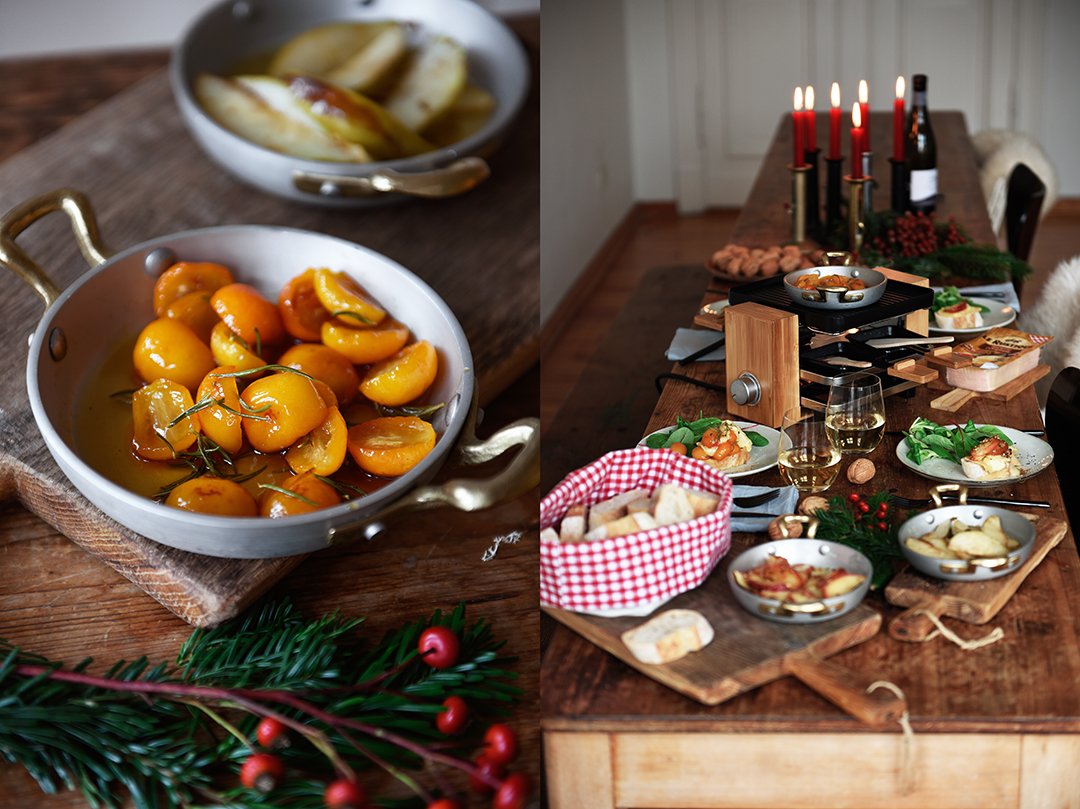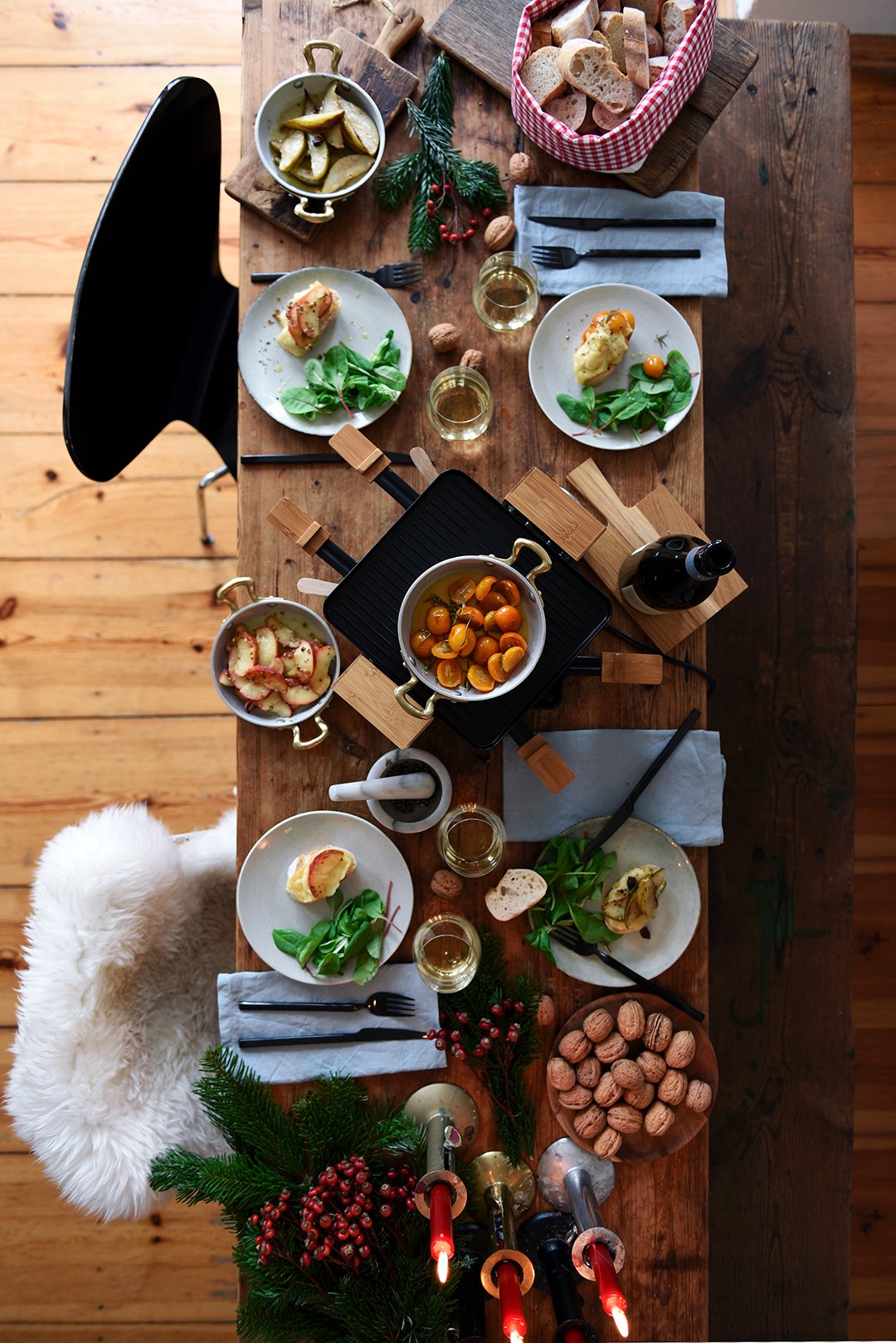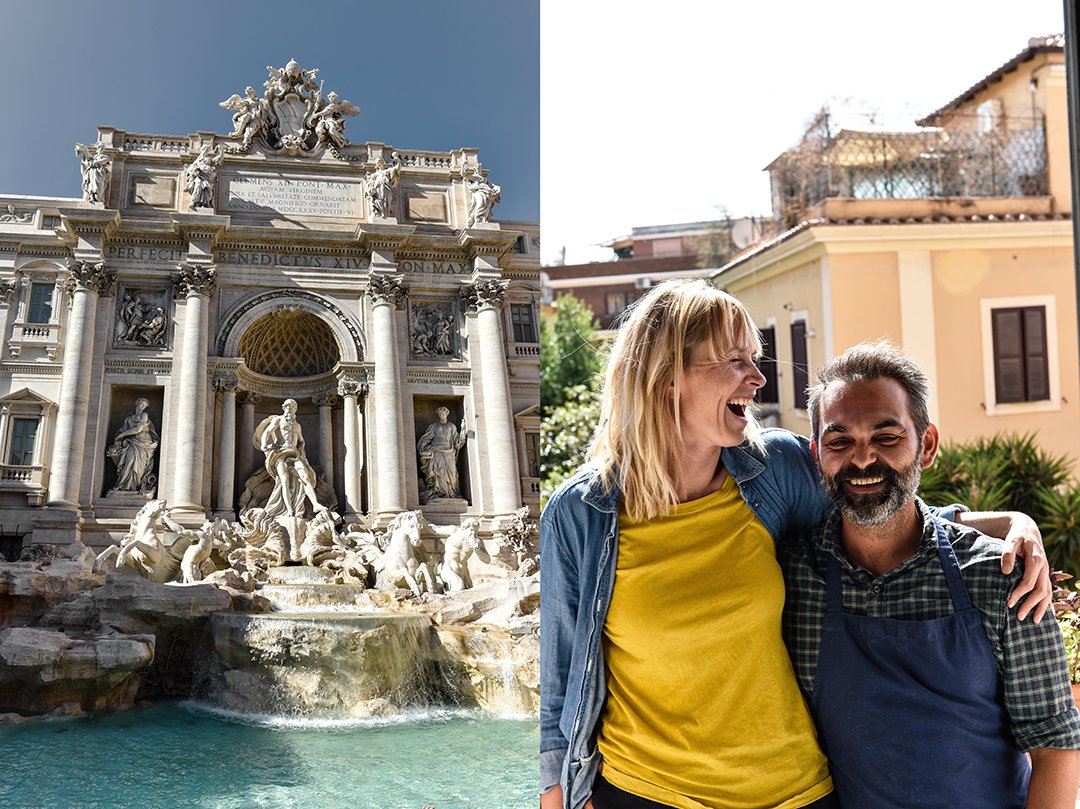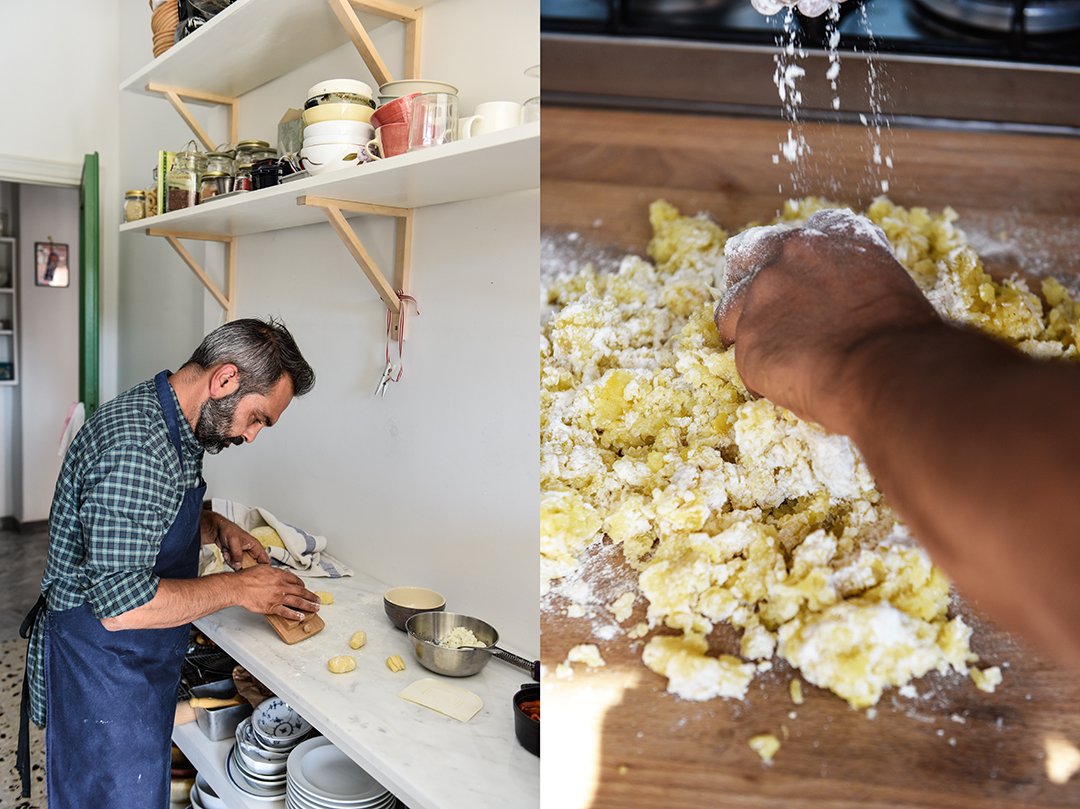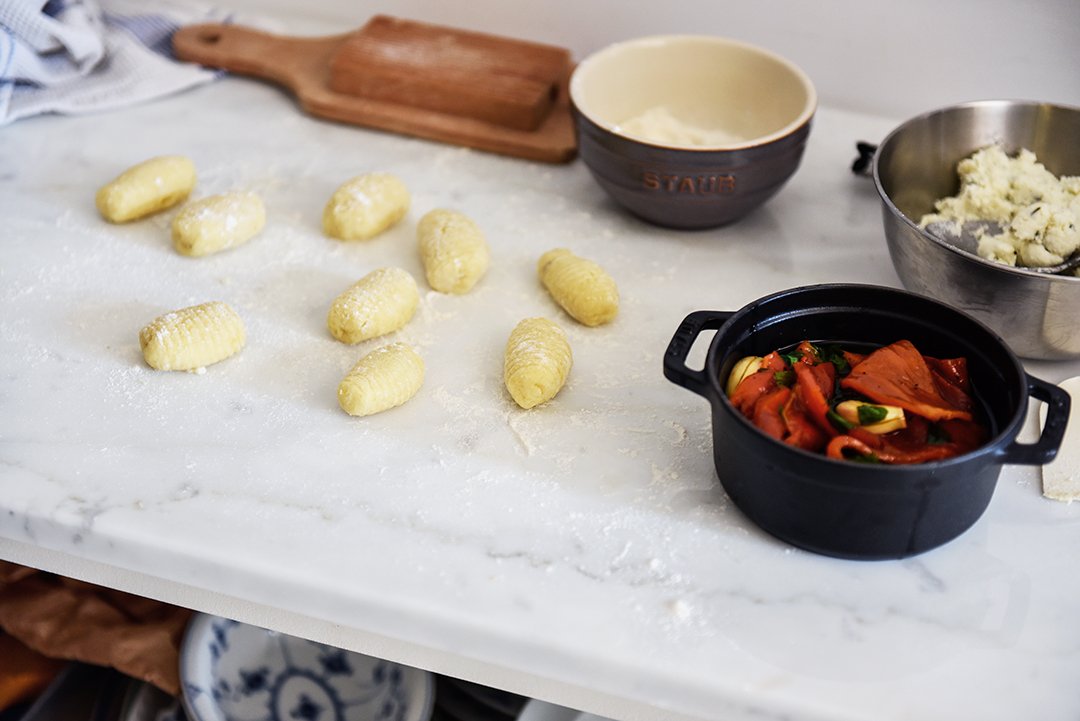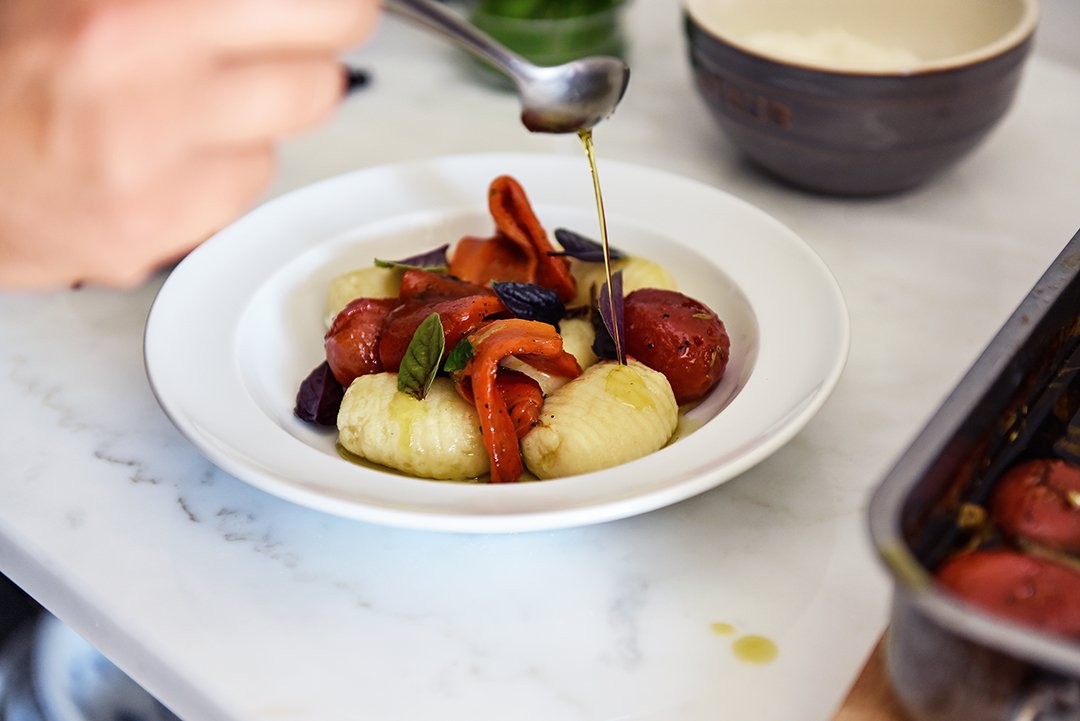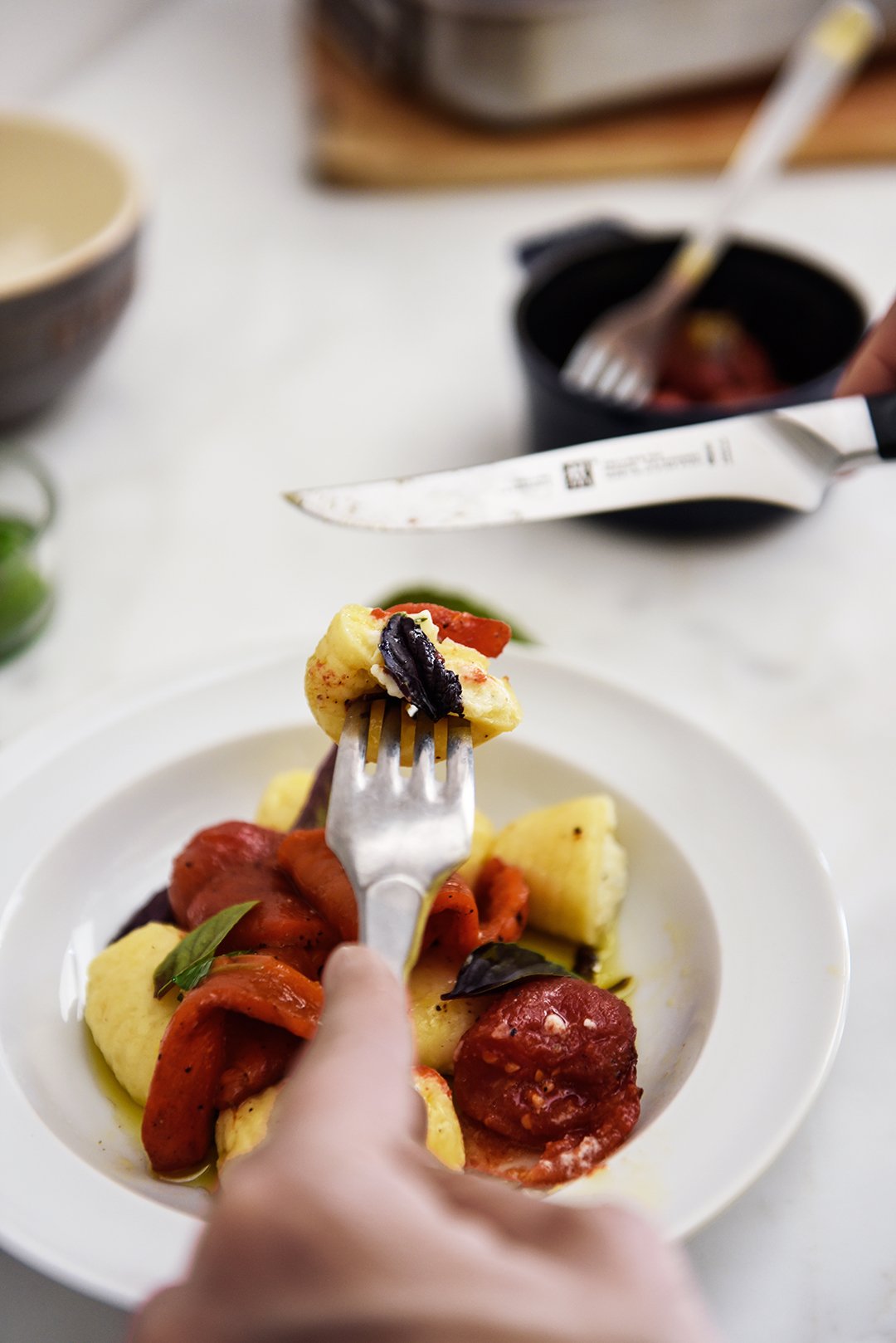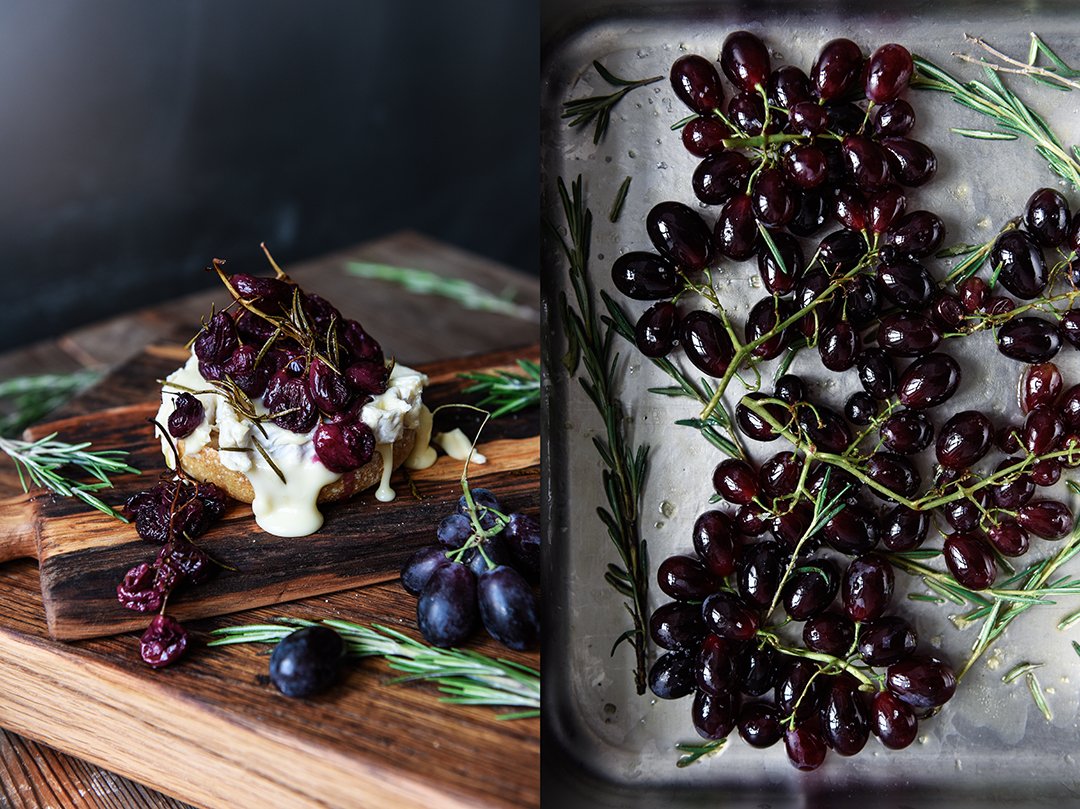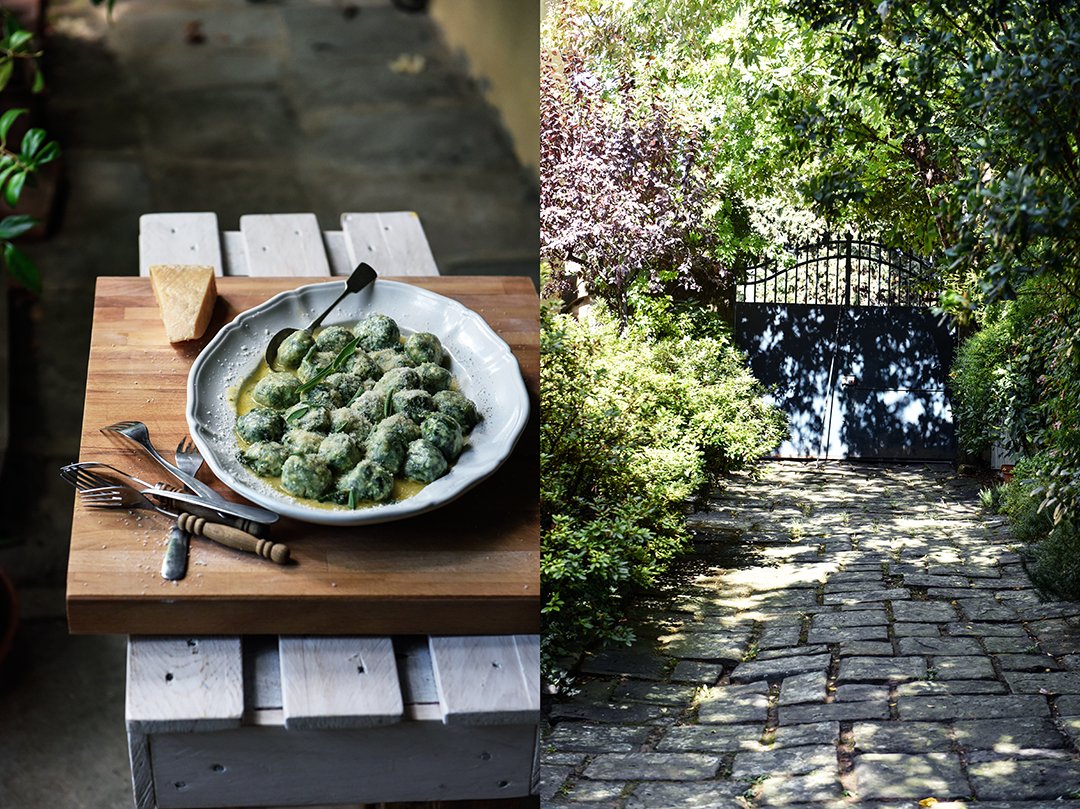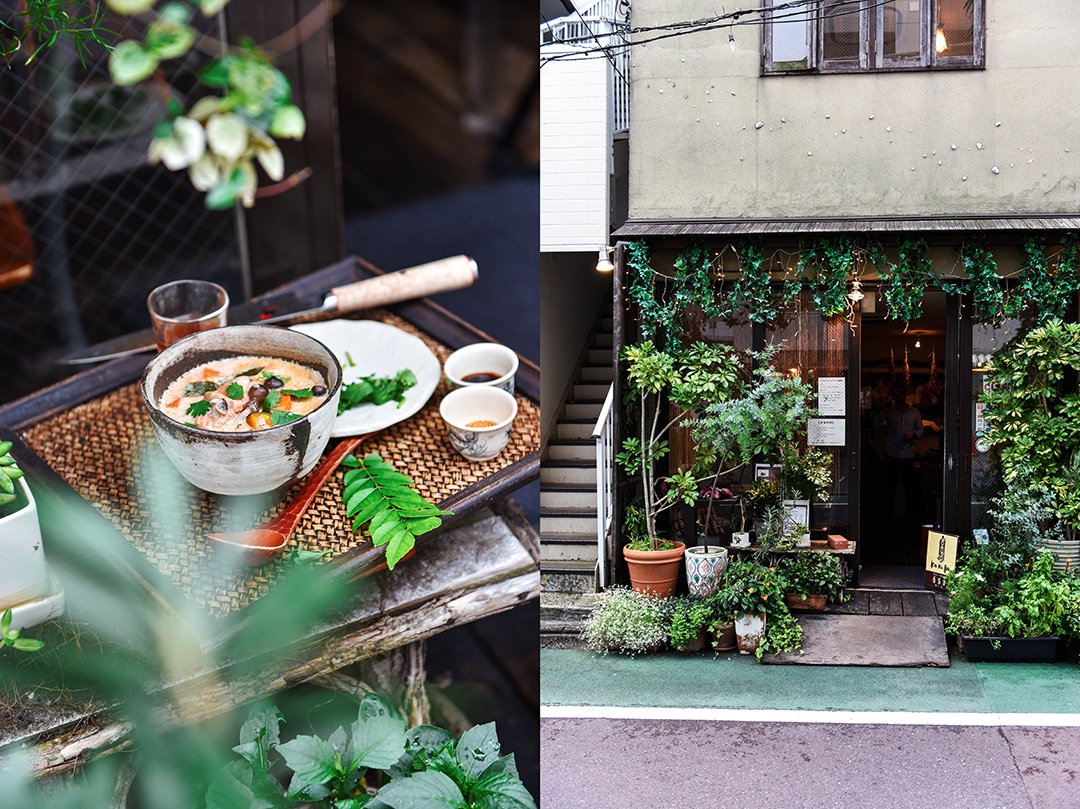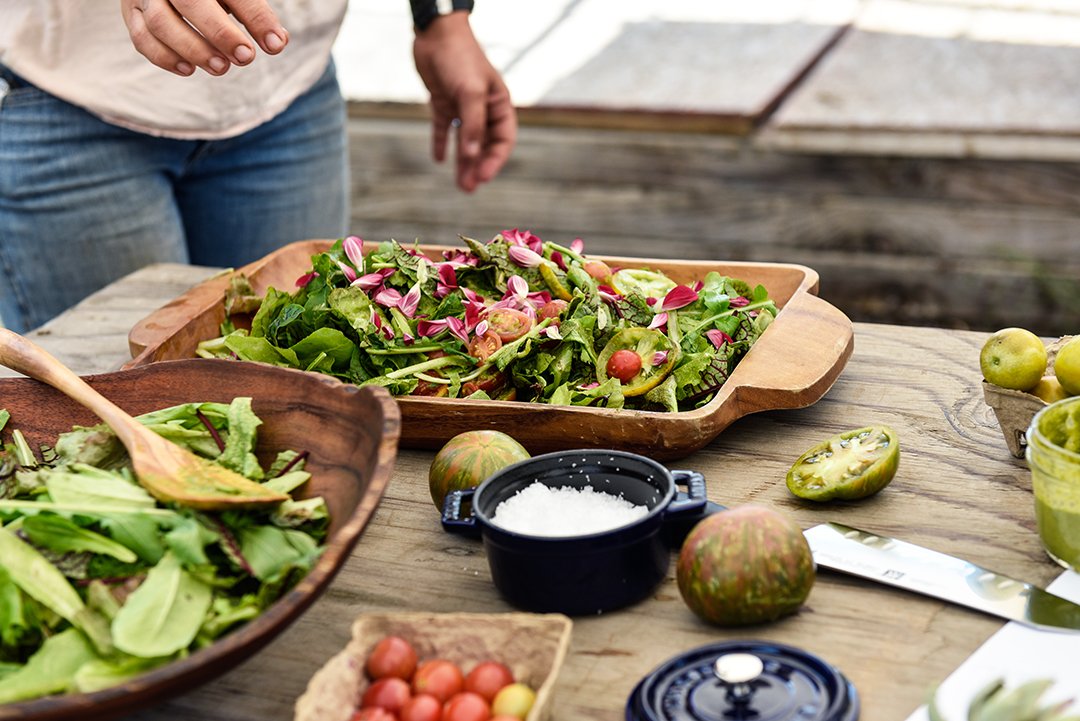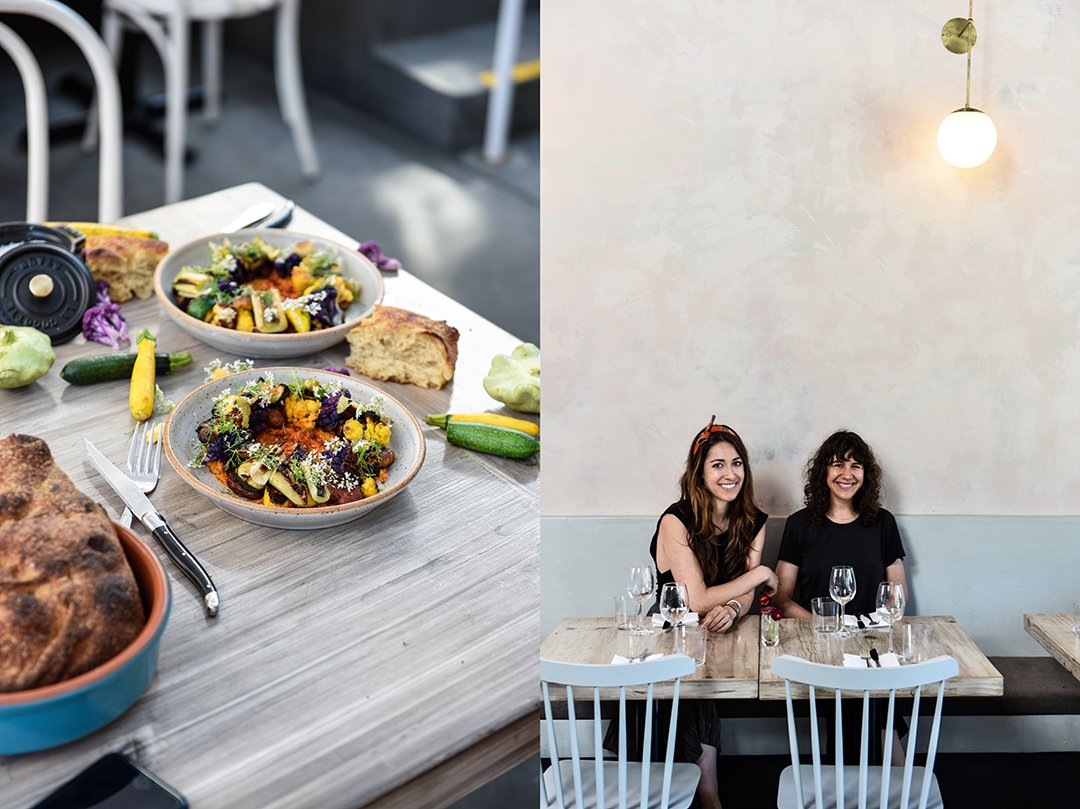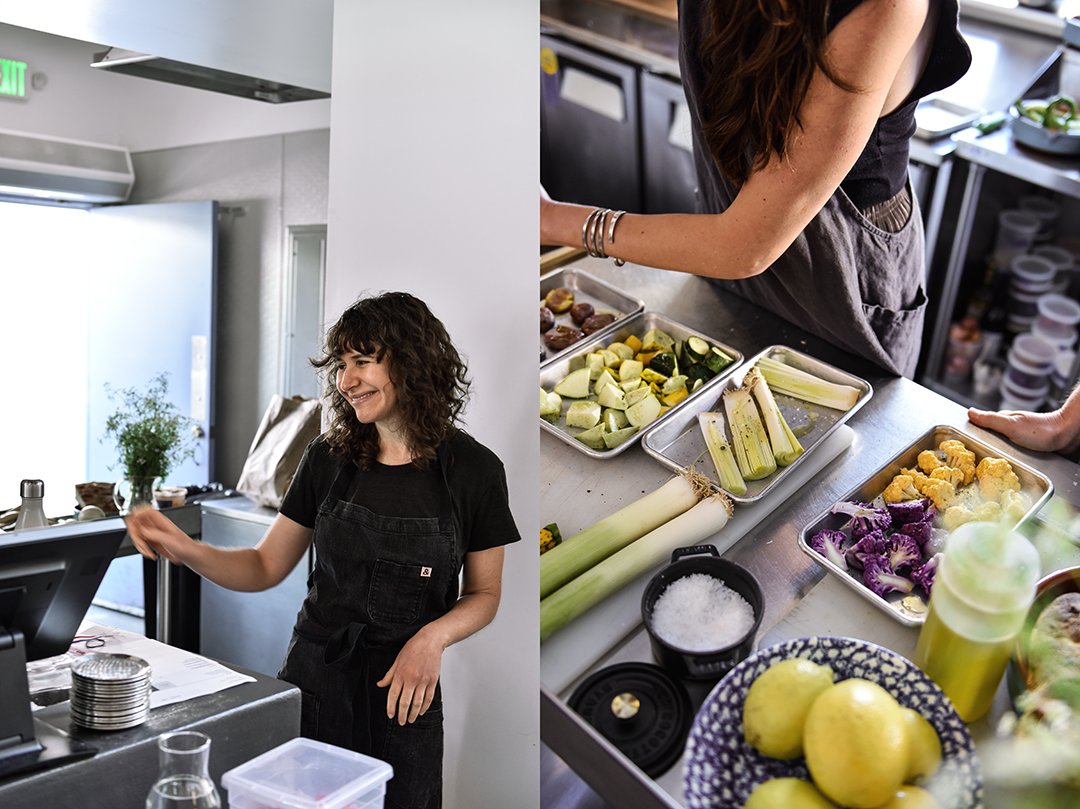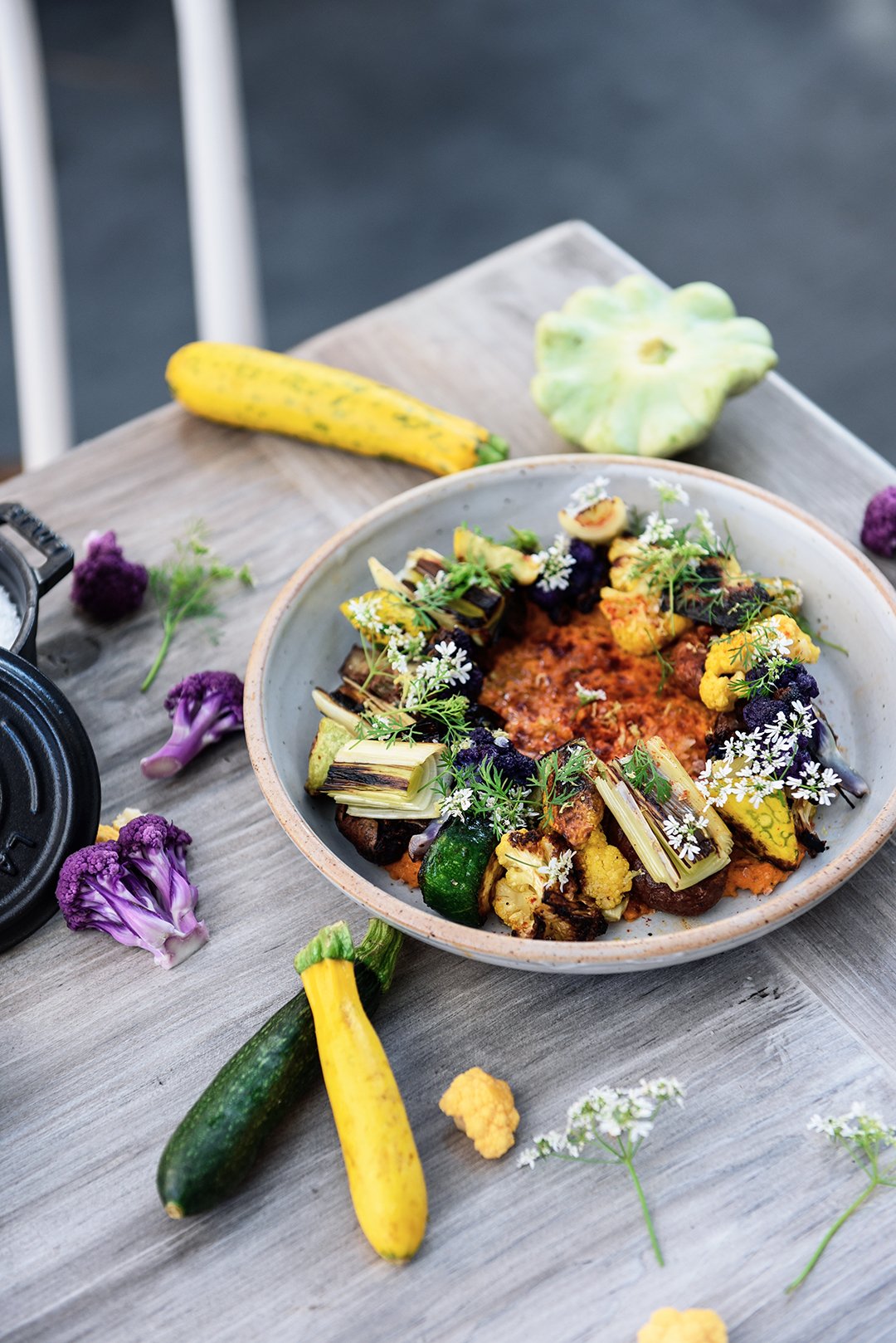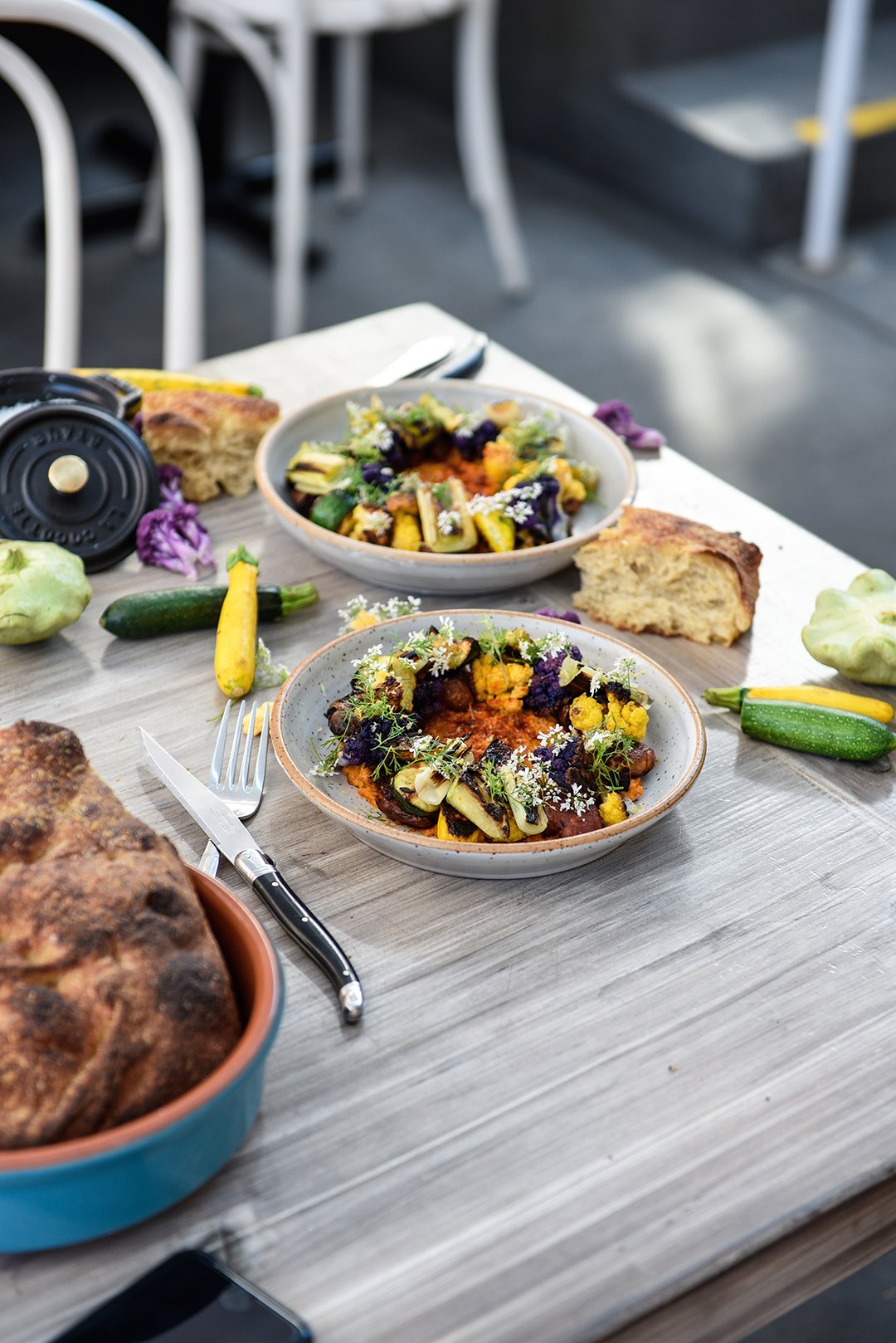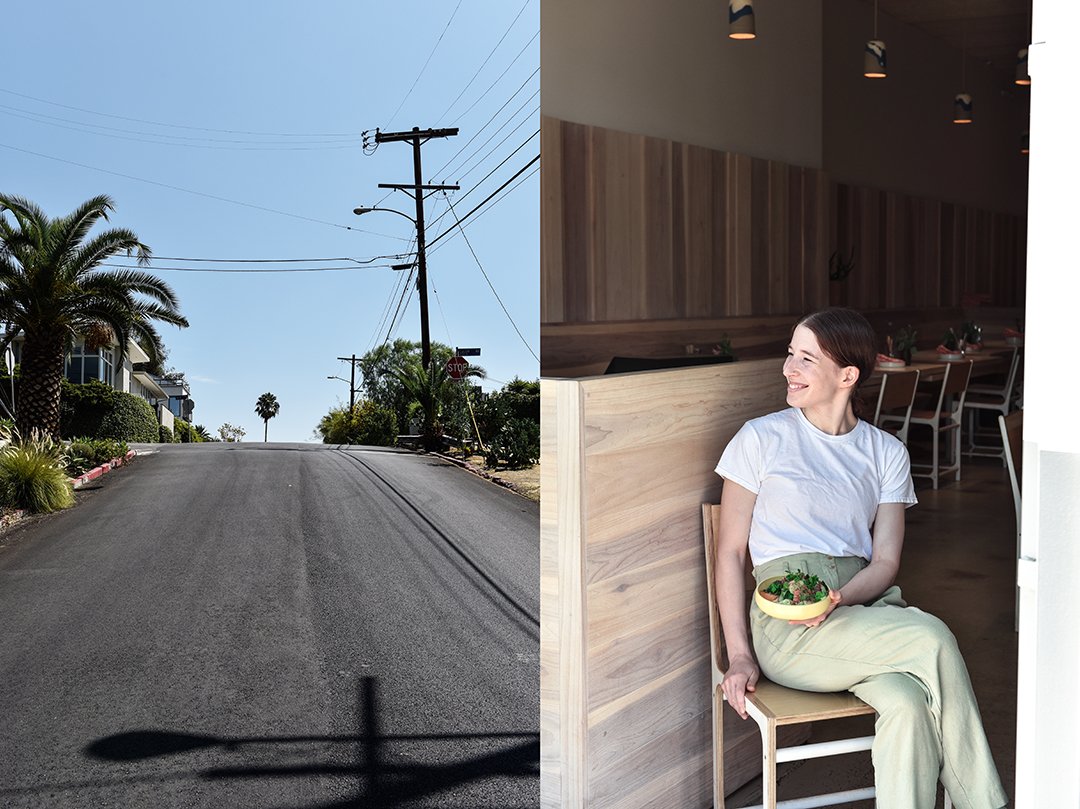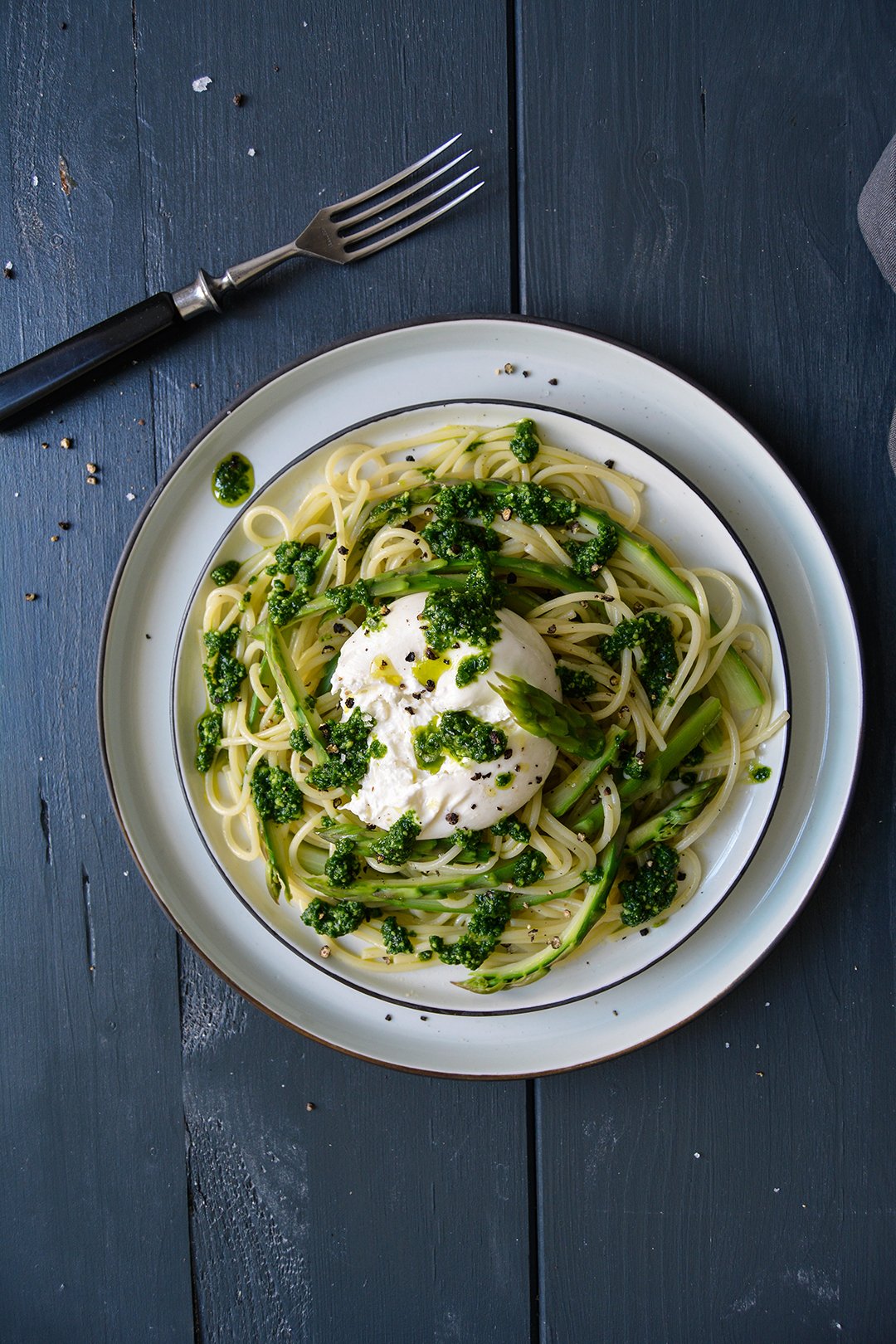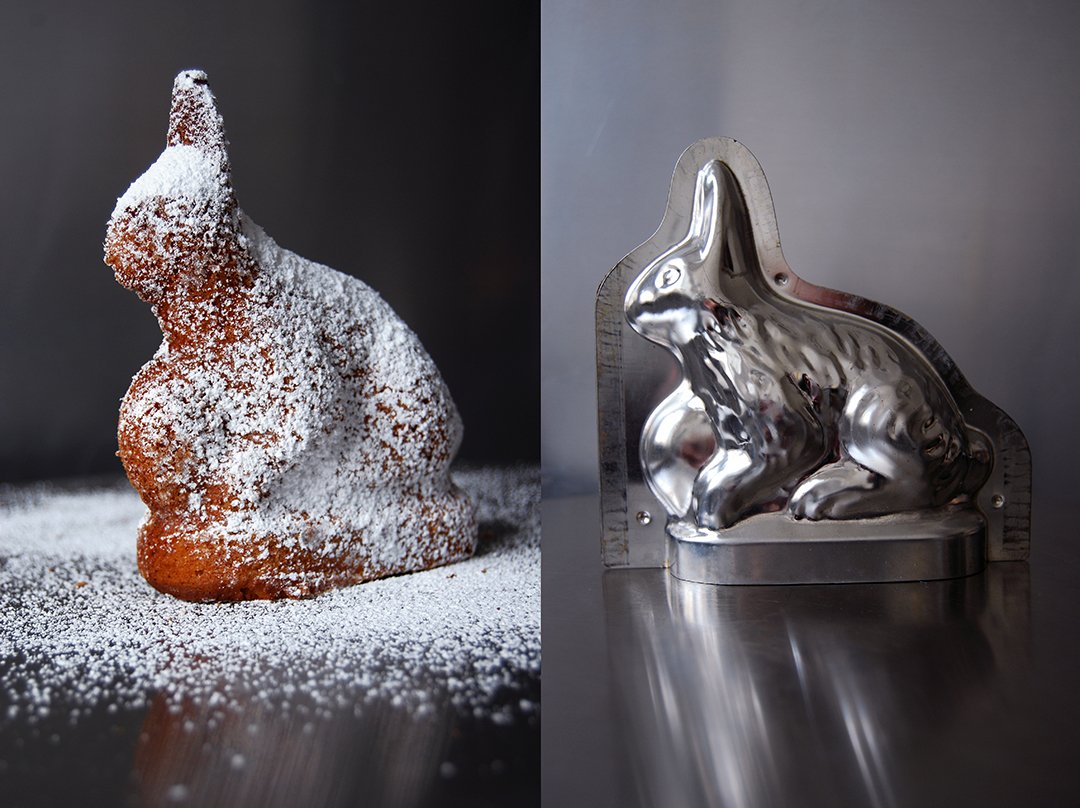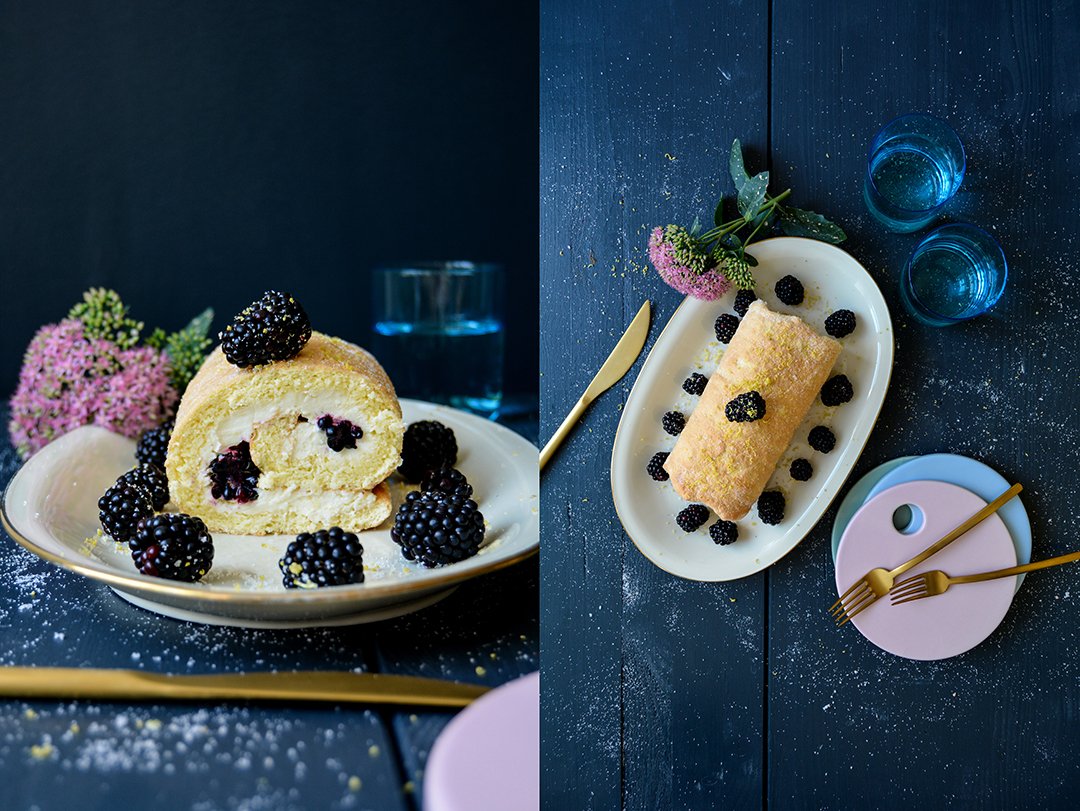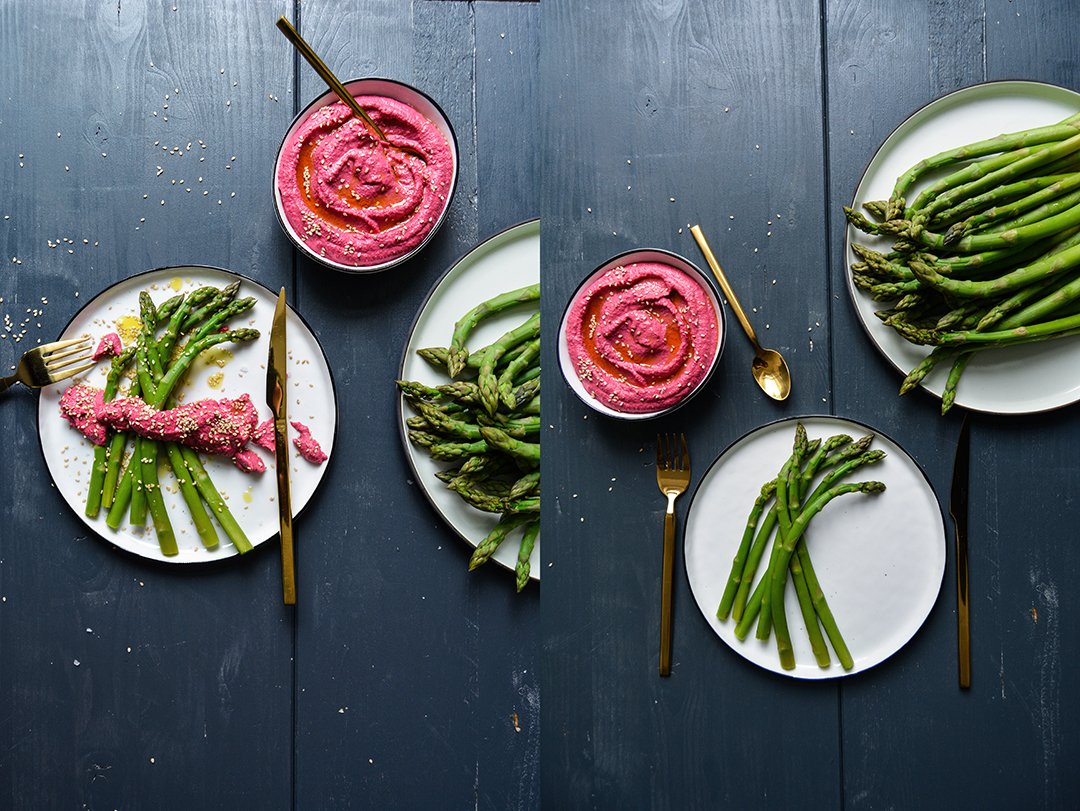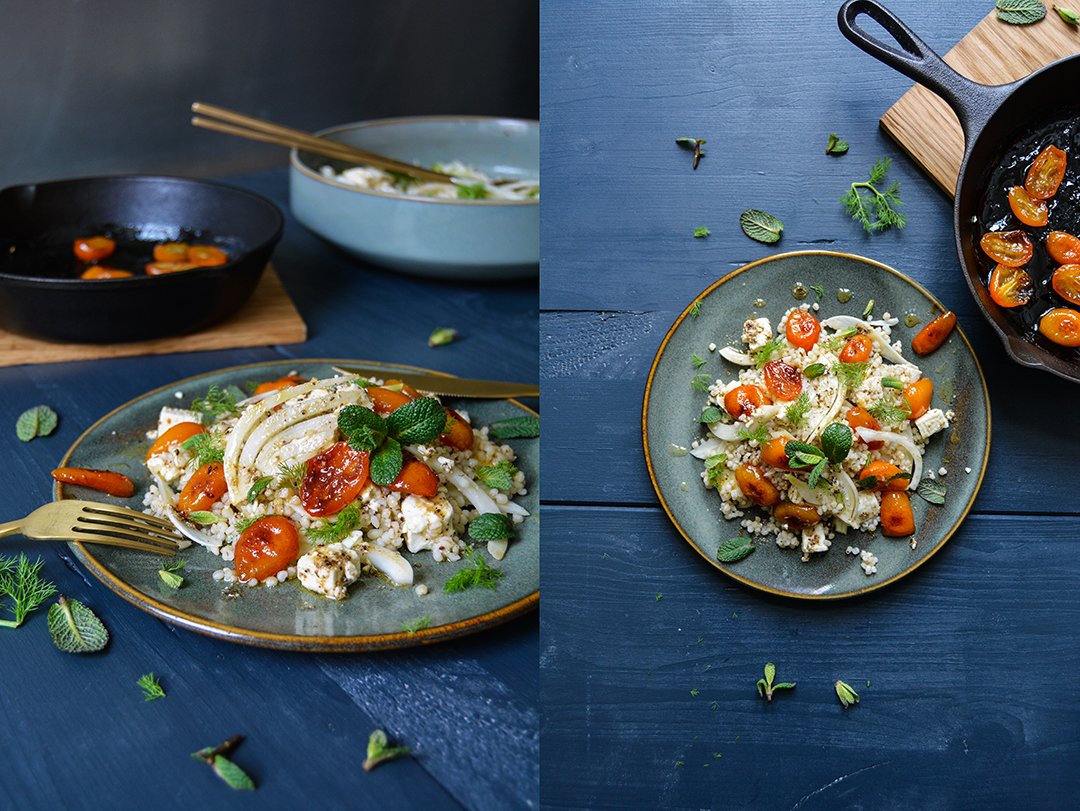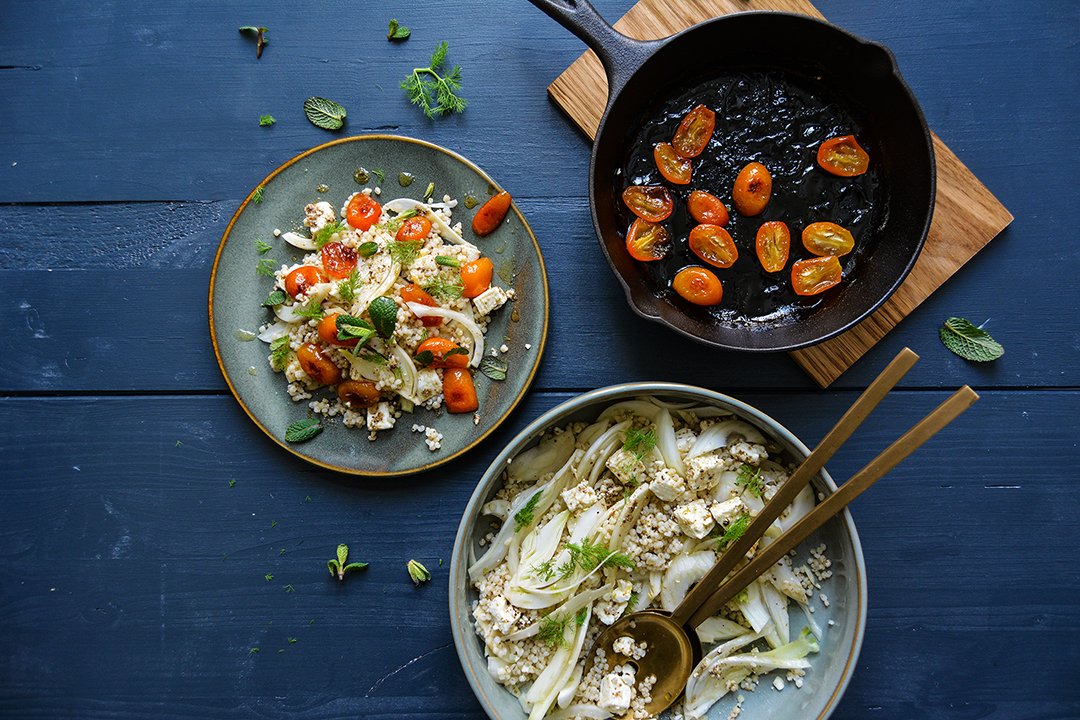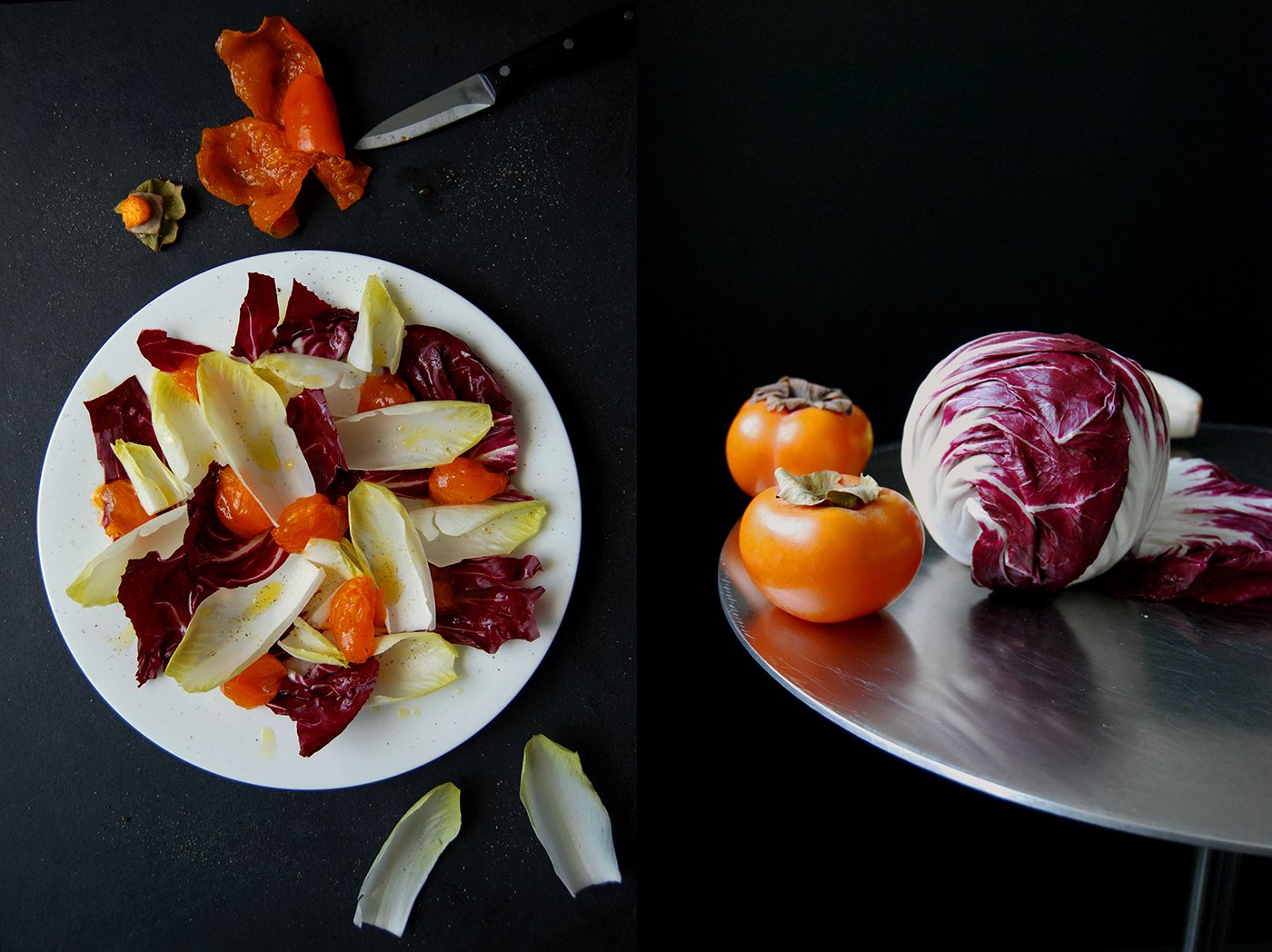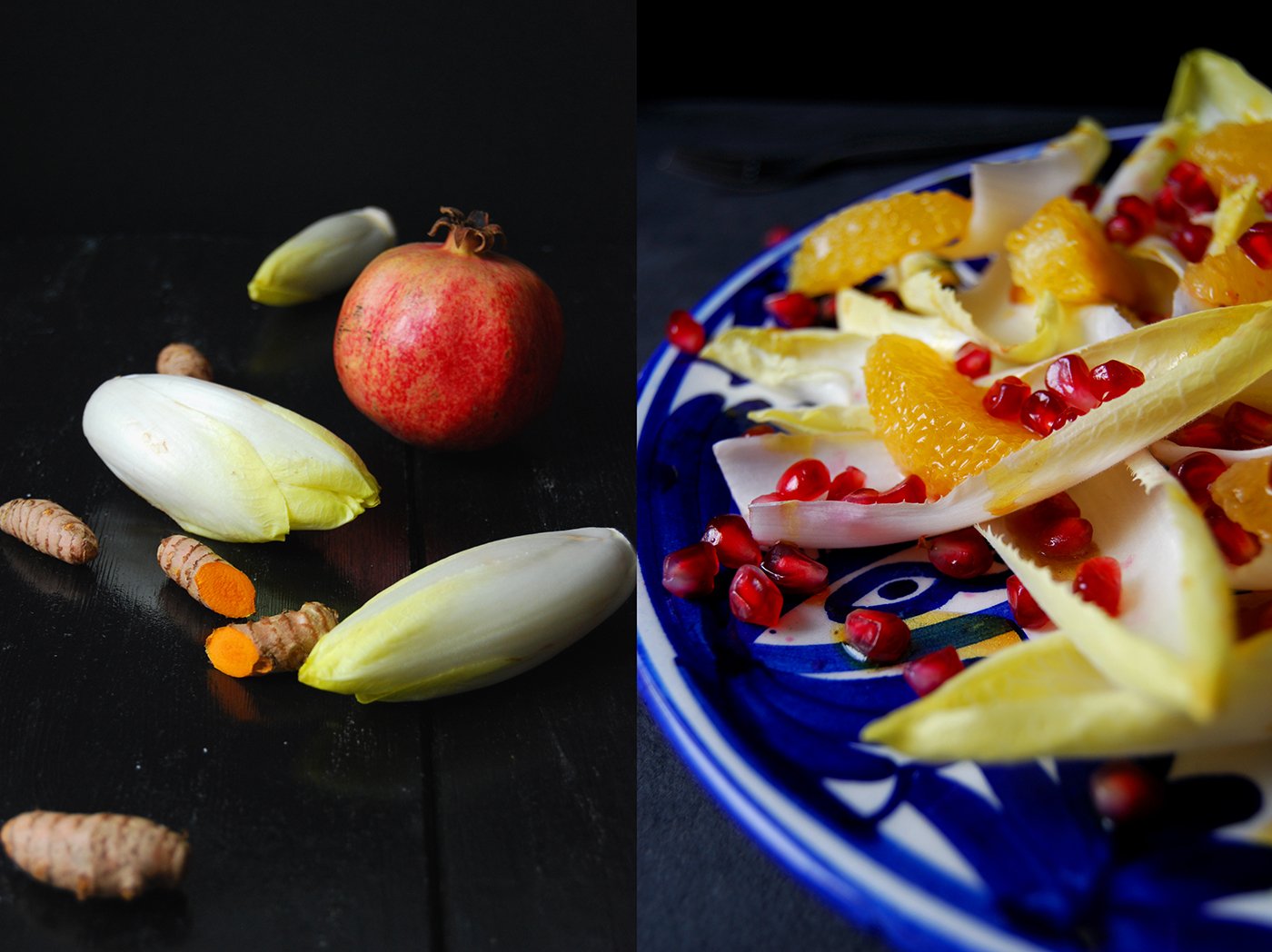Grilled Raclette with Rosemary Kumquats, Coriander Apple & Star Anise Pear
The light dimmed, tall candles casting flickering shadows on the ceiling, the room filled with the dry heat from the crackling fireplace and the smell of burnt wood and cheese lying in the air like a heavy cloud. When it's time for Raclette at my mother's house in the countryside, it's a celebration of everything that I connect with coziness. Surrounded by family and friends, everybody gathers around the sizzling Raclette grill to watch the magic happen: aromatic cheese melting and dripping, golden bubbles bursting and splashing as they touch the glowing grill, and the rind turning into smokey charred bites.
When you eat Raclette at a snow covered hut in the mountains, you would most likely enjoy it the classic way, with boiled potatoes, raw spring onions, pickled vegetables like gherkins (cornichons) and pearl onions, and lots of crushed or coarsely ground black peppercorns. The cheese needs added acidity, which can come from the pickles but it can also come from fruit.
So here's the fruity way to enjoy the fragrant melted cheese on a crusty baguette: I skip the pickles and go for Raclette with rosemary kumquats, coriander apple, and star anise pear. Kumquats cooked with honey and fresh rosemary turn the tiny citrus fruits into soft and caramelized bites. Pear wedges seared in star anise butter taste like Christmas and apple wedges softened in coriander butter are sweet, aromatic, and slightly sour. That's the colorful trio to complete my rustic Raclette table but you could also add roasted grapes or plums, or juicy persimmons. Whatever fruit you would normally eat with cheese will fit; it can only become better with a little heat, either in the pan on the hob or under the grill. The heat softens the fruit's texture and makes the flavor even more concentrated. I would keep the side dish simple, you can serve the grilled Raclette with a quick green salad.
My mother always uses a very old Swiss made grill that's rather large. It can hold half a wheel of Raclette, melting the surface where the cheese is cut in half, and then you scrape the melted layer right off the wheel onto your plate. It's a lot of fun, but it's heavy, you need a lot of people to eat up half a wheel of cheese, and you can only feed the hungry crowd in batches - around two people every time you scrape the top layer off, then the half-wheel needs to go under the grill again. This is not necessarily a bad thing seeing as we're talking about a meal that's rather rich and filling. A break once in a while doesn't harm the hungry cheese lover, but if I want to throw a cozy Raclette party just for two (or maybe a couple friends), I go for my more practical tabletop grill with single Raclette dishes instead. Then I opt for sliced cheese and grab Le Rustique's Raclette l'Originale. It's aromatic yet not overpowering and melts like butter. When I use sliced cheese I remove the rind, and if you're after that smokey burnt touch you can just leave the Raclette on a little longer until the charred bubbles burst under the grill.
Thanks to Le Rustique for sponsoring this post and reminding me of the coziest celebration of cheese: watching - and eating - bubbling and crackling Raclette.
Grilled Raclette with Rosemary Kumquats, Coriander Apple and Star Anise Pear
You'll need a Raclette grill for this recipe.
Serves 3 to 4
For the fruit
2 tablespoons honey
2 tablespoons fresh rosemary needles (whole needles, not chopped)
12 fresh organic kumquats (or canned kumquats, drained), cut in half lengthwise and seeds removed
4 tablespoons freshly squeezed orange juice
Unsalted butter, to cook the pear and apple
3 star anise
1 large, firm pear, cored and cut into thin wedges
2 teaspoons coriander seeds, crushed with a mortar and pestle
1 large baking apple, cored and cut into thin wedges
For serving
About 500-600g (18-21 ounces) sliced Raclette cheese (for a tabletop grill with single Raclette dishes), rind removed
1-2 crunchy baguettes, sliced
Crushed or coarsely ground black peppercorns
Optional
2 large handfuls mixed small leaf lettuce (young spinach and chard, mâche or corn lettuce)
Olive oil
Balsamic vinegar
Fine sea salt
Finely ground pepper
For the kumquats, in a small, heavy pan, heat the honey over high heat until bubbling. Add the rosemary, kumquats, and orange juice and cook, turning once, for 3-4 minutes or until golden brown and soft - mind that the kumquats don't burn. Set the pan aside and keep warm.
For the pear, in a medium, heavy pan, heat 2 tablespoons of butter and the star anise over medium-high heat until sizzling. Add the pear wedges and sauté, turning once, for about 3-4 minutes or until golden brown and tender. Set the pan aside and keep warm.
For the apple, in a medium, heavy pan, heat 2 tablespoons of butter and the coriander seeds over medium-high heat until sizzling. Add the apple wedges and sauté, turning once, for about 3-4 minutes or until golden brown and tender. Set the pan aside and keep warm.
Melt the cheese, one slice at a time, under the Raclette grill until bubbly then scrape onto a slice of baguette, top with kumquats, apple wedges, or pear wedges and season with crushed black pepper.
You can serve the grilled Raclette with a simple green salad on the side: Divide the mixed lettuce leaves among the plates, drizzle with a little olive oil and balsamic vinegar, and season to taste with salt and pepper.
Enjoy!
Meet In Your Kitchen | Love, Rome & Gnocchi
Imagine your friends throw an opulent dinner party in the pulsing heart of Rome on a Saturday night und you take over their kitchen hours before the guests arrive with a film team of four to peek over your hosts' shoulders into their pots and pans. Sofie Wochner and Domenico Cortese dealt with our little invasion with remarkable patience. They even welcomed us with big smiles on their faces and a plate full of fresh buttery Danish cinnamon buns in their hands.
The passionate couple is a confident team in the kitchen, they complement each other and combine two worlds that are geographically and culturally far apart, but somehow match smoothly. Sofie is a Danish baker and pastry chef with the impulsive temper of an Italian Signorina, self-taught Chef Domenico comes from Calabria, from the southern tip of Italy, but totally lacks the Mediterranean drama that one would expect. His voice is calm and his movements are concentrated, he's quiet and focused when he works in the kitchen. He says he was born in the wrong country, he feels much closer to the northern European mentality, whereas his woman only feels as free and inspired as she wants to be when she's in her adopted city, in Rome.
A city kitchen is often a space of improvisation and elaborate compromises, the smallest but also the most charming room of an apartment. It's the place where everybody meets at a party, making use of every square inch, squeezed and snuggled in, the happy crowd talks, eats, and drinks until dawn. Our hosts' kitchen is just such a magical place, but it's also a room where the two chefs manage to create the most wonderful dishes for private gatherings, catering, and highly anticipated supper clubs. When it's time to open the doors for their Eatery In Rome pop-up restaurant in their flat's dining room, the kitchen turns into a busy laboratory functioning like clockwork. Loaves of bread and cakes baking in batches in the single oven, pillowy gnocchi rolled and shaped on the wooden board at the window, and bell peppers roasting in the flames of the old gas cooker. The room is bright, facing the pretty balcony, Domenico's beautiful little herb garden where basil, thyme, and rosemary grow happily under Rome's ever shining sun - all waiting to be used in the masters' glorious recipes, like their Stuffed Gnocchi with Mozzarella di Bufala, Confit Tomatoes and Flame-roasted Bell Peppers (you can find the recipe below). The potato gnocchi melt in your mouth like fluffy clouds, the creamy filling makes it smooth and fits perfectly to the candy-like tomatoes and smoky peppers. It's a delicious stunner, a colorful homage to the beauty of Italian cuisine.
In the past few months, the busy duo made their dream come true and started working on their new baby: Marigold. If you would like to support Sofie and Domenico and help them fund their new restaurant and micro bakery in the Roman neighborhood Ostiense, click here.
Many new Meet In Your Kitchen features took me to California, Japan, France, and Italy in the last few months. Thanks to Zwilling for sponsoring these features for our culinary trip around the world!
Mozzarella di Buffala stuffed Gnocchi with Confit Tomatoes and Flame-roasted Bell Pepper
By Domenico Cortese & Sofie Wochner – Marigold, Rome
You can find the German recipe here.Prepare the confit tomatoes and roasted bell pepper a day in advance.Serves 4
Flame-roasted Bell Pepper
1 large red bell pepper
3 cloves of garlic, crushed
1/2 medium bunch of parsley, leaves only, chopped
Fine sea salt
Ground black pepper
About 150ml / 2/3 cup olive oil
You can either grill peppers in the flames of a gas cooker (that's what Domenico does) or grill or roast them in the oven (on the highest temperature, turning them every few minutes until partly black), which is the safer method.
Place the pepper on the gas flame of your cooker set on medium heat. Turn the pepper every now and then, mind that the skin turns dark and forms blisters evenly on all sides. Transfer the hot pepper to a bowl and cover with cling film, let it sit for 15 minutes. Use a small, sharp knife to peel the pepper, cut it in half, and scrape out and discard any seeds and fibers. Cut into strips and transfer to a bowl. Add the garlic, parsley, salt, and pepper and cover with the olive oil. Cover the bowl and let it sit for at least a few hours, or over night.
Confit Tomatoes
8 tomatoes, preferably Piccadilly tomatoes
Fine sea salt
Ground black pepper
3 medium sprigs fresh savory
4 medium sprigs fresh thyme
10 medium sprigs fresh basil
3 cloves of garlic, crushed
Olive oil
Bring a medium pot of water to a boil. Fill a large bowl with ice water.Clean and score the skin of the tomatoes. Blanch them for 20 seconds in the boiling water, then transfer to the ice water. Use a small, sharp knife to gently pull off the skin without cutting them. Transfer to a small baking dish, season with salt and pepper, and cover with cling film. Let them rest in the fridge overnight.
Take the tomatoes out of the fridge about 1 hour before roasting them. Preheat the oven to 130°C / 275°F.
Spread the herbs and garlic on top of the tomatoes and cover them completely with olive oil. Roast for about 4 hours or until they are soft.
Gnocchi
For the filling
150g / 5 ounces mozzarella di buffala
50g / 2 ounces Parmesan
3 sprigs fresh basil, leaves only, plus a handful leaves for serving
1/2 tablespoon olive oil
Fine sea salt
Ground black pepper
For the gnocchi
500g / 18 ounces floury potatoes
1 small egg
50g / 2 ounces Parmesan
Fine sea salt
Ground black pepper
Freshly grated nutmeg
100g / 3/4 cup plus 1 tablespoon flour, type 00
For the filling, purée the mozzarella, Parmesan, basil, olive oil, salt, and pepper in a food processor or blender until smooth. Season to taste with salt and pepper and chill in the fridge for 10 minutes.
For the gnocchi, boil the potatoes in unsalted water for about 30-40 minutes or until soft. Drain and let them rest for 10 minutes. Peel the potatoes and press them through a potato ricer onto a large chopping board or kitchen counter, form a little dome. Add the egg, Parmesan, salt, pepper, and nutmeg and, using your hands and a dough scraper, mix everything together. Add the flour in batches and mix quickly until the gnocchi mixture is combined. Add more flour, if it's too sticky; mind not to over mix it.
Form the gnocchi while the mixture is still warm: Cut off a handful of dough, keep the remaining dough covered with a tea towel, and roll it into a 2.5cm / 1 inch-thick roll. Cut into 1cm / 0.5 inch-thick slices. Using 2 fingers, make a dent in the middle of each slice. Add a tablespoon of the filling and close the gnocchi by rolling it in your hands. Transfer the gnocchi to a baking sheet dusted with flour. When all the gnocchi are filled, cook them immediately in salted water (it should taste like the sea) for about 3-4 minutes or until they raise to the surface; or freeze them, but don't keep them in the fridge.
Using a slotted ladle, transfer the gnocchi to the plates. Arrange the confit tomatoes and roasted peppers on top, drizzle with the oil used to roast the tomatoes, and sprinkle with fresh basil.
Buon Appetito!
Can you tell us a little bit about yourself?
Sofie Yes, I’m Danish and I moved to Rome four years ago to live with Domenico. Straight away, we started our little pop up restaurant in our home here in Rome. I make the bread and the pastry. So we divide the work between the two of us.
And you’re the chef, Domenico?
Domenico Si! Our work is completely separate. I’m not so good with pastry because I don’t like to follow the recipe, but I like the freestyle more.
Sofie You’re a creative soul.
Domenico I'm a chef and I don't know how to work with recipes. I need to be creative and use my inspiration – from my work at the American Academy as well as from my Italian background. Now I have arrived at a place in my life where I have really found my own style.
When did you arrive here in Rome?
Domenico It was in January 2000. Before that, I spent 5 years of my life in Holland and I then decided to come back to Rome - especially because part of my family is here.
Where are you from originally?
Domenico I’m originally from Tropea, a small town in Calabria, where I grew up until I was 18.
Sofie, what made you leave Denmark?
Sofie I’ve always been extremely adventurous and I always felt that maybe Denmark, or maybe Copenhagen, was a little bit too small. That the mentality is – without sounding arrogant – but it’s a bit closed and I’m kind of a loud person (laughing)! So I felt coming to Italy, I kind of came home in a way. Here, there is space to be who you are. You don’t need to fit into a little box. But I still love Denmark and Copenhagen and where I grew up. I go back quite often but I really feel at home in Rome.
Domenico Lucky me!
How do you bring your two worlds together, the Danish and the Italian mentality?
Sofie In many ways I’m more Italian than Domenico is. And he’s more Danish than I am in the sense that Domenico is very precise and he’s always on time. Yes, you’re quite organized and structured.
Domenico Honestly, maybe too much sometimes!
Sofie You’re too Danish sometimes (laughing)! In many ways, I’m very attracted to the southern part of Europe because you’re allowed to express your passion and your feelings in a way that comes very natural to me. I feel welcome and I feel very much at ease here. For us, I think we meet in the middle. Of course, it’s not always easy…
Domenico No, not really!
Sofie …being from two different cultures. A relationship is always hard work but in many ways we also find a way to balance it out by being attracted by each other’s cultures. Domenico could easily live in Denmark if that happened one day but I prefer to live here!
Can you tell us a little bit about your supper clubs?
Sofie Yes, it started 3 1/2 years ago now. It came a little bit by coincidence. We both had this dream about opening a restaurant. And you don’t do that overnight. So we thought maybe we could just start at home. How many tables can we fit into the living room?
Domenico Yes, let’s try and see how it will work. Which kind of guests can we get?
Sofie So it started a bit like that and from the beginning it’s been quite successful. It really gave us the possibility to try out our own style…
Domenico ... to show to our guests what we can do.
Sofie Domenico, you could really try to work on your own style and I think you discovered more and more about who you are through your cooking here than you’ve done anywhere else. And it’s fun! It’s fun to play around with so many things and we are still using the best, seasonal, and local produce. We don’t necessarily cook amitriciana – we try to use the products in a new way, but still keeping the roots in the simplicity of the Italian kitchen…
Domenico …the basis is the Italian cuisine but of course we kind of try to change a little bit or invent something new.
Sofie It’s a feast! In our pop-up restaurant at home we have 12 people sitting at a long table, so you’re eating with people you don’t know but who you get to know very quickly. It’s one big dinner party with people you don’t know which is very unusual here. And every dinner and every evening is completely different to the others, but there’s always a good energy.
Domenico Yes, I can hear it from the kitchen!
Sofie People are chatting away…
Domenico …and laughing! It’s nice!
Did you ever have a funny experience?
Sofie We had a very, very romantic experience! We had two guests, they both came here before, and then one evening, they were here at the same time – they didn’t know each other – and they started to chat over the table. So they met and they got together and then they came back with their parents and they’re in a serious relationship. And they keep coming back! I think they’ve been here like four times! So they kind of grew with us. It was a really cute thing and they are such lovely people.
And then one day they will bring their children!
Sofie Exactly (laughing)!
Do you think that the people who come to Rome, the tourists, have a very clear idea of what they expect to eat when they come to this city?
Sofie Yes. I think it’s fair enough because you come to the most ancient city in the world, so of course it’s not vibrant, modern, things are not changing every half year with a new trend. Of course you know what you’re getting. Unfortunately, because there are so many tourists passing through Rome the quality of even these key dishes in the city is just not good enough. They don’t respect people enough here, and they’re not being proud enough about what they do. I think that’s disturbs us sometimes. Who doesn’t love a creamy cacio e pepe? Or a carbonara? But you don’t need to put cream in there! There shouldn’t be cream in there. They don’t expect that the people coming here to visit can actually taste what they eat. That’s a bit of a shame because Rome also doesn’t have the best reputation. In Paris, there has been this small revolution and I think slowly I can see it happening here too. The younger generations are observing that there is something to be done here, that we’re losing something if we don’t respect our traditions more. Even though the traditions are very strong, it’s not expressed in the actual plate in front of you.
Domenico, what is your greatest kitchen hack?
Domenico For the gnocchi, you need to have really good, starchy potatoes. You can choose between two kinds of potatoes, but the trick to make really good gnocchi is to have starchy potatoes!
What about you, Sofie?
Sofie Being a Dane, I have to mention Danish butter because I actually use Danish butter here. Italian butter doesn’t have the right structure. It’s really important when you do pastry that you use the right kind of butter. It doesn’t necessarily need to be organic either. Often, organic butter tends to hold too much water which means your pastry or your cake can become wet in a way – it doesn’t get the right structure. I can only use French butter or Danish butter in my pastry. So, I believe the basic key is to use really, really good butter. And lots of it (laughing)!
If you could choose one person to cook a meal for you, who and what would it be?
Domenico My mom. I have a lot of memories as a child, but I remember I really liked the minestrone. She used to strain everything but it was so good.
Sofie I’m very, very fond of the way Chad Robertson from Tartine Bakery in San Francisco bakes his bread. I even went there to see them bake. But for him to bake a loaf of bread for me, take it out of the oven and serve it to me with Danish butter (laughing), I think I would be in heaven!
Mille grazie, Sofie and Domenico!
Meet In Your Kitchen | Sheep, Peace & Tuscan Pecorino at Podere Il Casale
The light was warm and golden as we drove down the rocky alley to Podere Il Casale. It was late in the afternoon, later than expected, but that's what happens when you enjoy Tuscany. The sun was so low that it almost touched the Tuscan hills that seem to embrace the secluded farm tucked in between Pienza and Montepulciano. I came to visit the celebrated Swiss cheese maker Ulisse Braendli, to see his sheep and goat herds, and try his Pecorino, but I found so much more. There is a silent peace laying over this farm like a blanket, it calms your mind as soon as you walk past the old terracotta-colored farmhouse. As you stand on the terrace, a breathtaking viewing platform, under fragrant pine trees protecting you like an umbrella, as you see the landscape laid out majestically in front of your eyes, soaked in dimmed shades of green and ocher, you can only smile and thank life for such unbelievable beauty.
All the people and places I visited in Tuscany for my culinary trip around the world together with Zwilling had one thing in common, they all give themselves into the hands of nature with great trust and respect. No matter what obstacles they have to fight, what problems they have to solve, they know that nature gives and takes and that there's a balance. It's not an easy life, but that's also not what Ulisse was looking for when he and his partner Sandra left their home country and started a new adventure in Italy almost 30 years ago. Life is tough on this piece of land that they bought, but it's also incredibly rewarding. They started with 3 sheep and now there are 200 of them, living an enviably good life under the Tuscan sky.
Ulisse loves Tuscany for being real, traditional, and romantically old-fashioned. Electricity only came to Podere Il Casale in 1980, before, it was a very simple, basic life. The farm is the perfect setting for his vision, to "help" nature create beautiful raw milk cheese. All the cheese, vegetables, and olive oil from the farm are organic, but that's not an option, that's the standard in his philosophy: "Conventional farming is strange, organic farming is normal. Wasting less of our food than the 40% that actually end up in the bin, is one of the solutions to open the doors for organic, local, and seasonal food for the broader population." His mother planted the seed for his critically creative mind, she taught him to be open and experiment. "I blame the 60s," says the cheese maker with a smile on his face.
The cheese at Podere Il Casale is made with just three ingredients: raw milk, rennet, and salt. Every kind of milk is different, depending on the four seasons, the weather, the soil, and the food that the sheep find on the fields. "Great food makes great milk and that makes great cheese – and every season makes a different cheese." That's the whole humble secret behind a Pecorino that so many people praise as one of Tuscany's best. When the animals are outside, when they eat good food and there's space, you have less problems with diseases, you don't need chemicals, you can keep it under control with homeopathic methods. The animals eat barley, oats, and beans when they are in the barn, their "power food", and hay and grass on the fields. Raw milk cheese has a strong connection to the place where it comes from, to the animals and the climate. To taste Ulisse's sheep and goat milk cheese, young and ripe, pure and refined with white truffle or saffron, was one of the purest pleasures during my trip in Italy. Unfortunately, we didn't have time to visit the farm's praised restaurant, but eating that wonderful cheese and enjoying the views of Pienza at sunset definitely made up for it.
When Ulisse stood amongst his sheep, playing with his two rowdy snow-white Maremma sheepdogs, the last rays of the low sun in our faces, I asked him what he loves the most about his life and he said: "To be free here on the farm. To do what I would like to do and not to make too many compromises – not to do something because it’s convenient."
Many new Meet In Your Kitchen features took me to California, Japan, France, and Italy in the last few months. Thanks to Zwilling for sponsoring these features for our culinary trip around the world!
Homemade Quark (fresh cheese)
By Ulisse Braendli - Podere Il Casale
Makes 1 pound
1.8l / 7.5 cups farm fresh milk, preferably still warm (don't use ultra pasteurized milk!)
Cheese starter culture (amount according to the package instructions)
Liquid rennet
In a large saucepan, slowly warm up the milk until it's about 25°C / 77°F, then stir in the cheese starter culture and take the pan off the heat. After 1 hour, add a tiny (!) drop of the rennet, cover the pot, and let it rest at room temperature for about 24 hours. The cheese is done, when the curd pulls away from the sides of the pot.
Transfer the milk mixture to a cheesecloth-lined strainer set over a bowl. Keep the milk mixture in the strainer at room temperature for 12-24 hours to drain the whey from the cheese, or until it reaches the desired texture; the whey should be clear. Whisk until smooth and transfer to a glass container, cover, and keep in the fridge for 2-3 days.
What made you leave Switzerland?
I decided to start a new experience and when you start a new experience, why not change the place? It was more a about the concept. What is also better here is a shorter winter…
And you don’t like winter?
No, I like winter – it’s better for relaxing but here, winter means you have to go in the forest to cut wood. It’s one thing if you have to heat for two months, but if you have to heat for six months, it’s much more work! But it’s better here – you can make olive oil which is a great product. After the butter experience, the olive oil experience is better. It’s great. Tuscany is a nice place – it’s very real, and has an old style. In Switzerland it’s difficult. It’s just another experience. Perhaps next time I wouldn’t choose Italy.
So you never had a close connection to Tuscany? You just looked at the world and said, “Tuscany!”
No, first it was Piedmont because it’s a bit cheaper! But it’s foggy, there are too many Swiss, and the people are really a bit weird (laughing). I would not say that Tuscans are really open, but they are a little bit better! The further south you go, the better the Italians – in my opinion!
When did you arrive in Tuscany?
In 1991.
How did you find this piece of land?
By chance. We were here for the first time. We had a good relationship to the farmer. He gave us time to find the money, he helped us a lot. It was very simple.
Was it a smooth transition? Did you have a chance to grow into it?
Yes, a bit. Obviously, he had helped us more for the network and less for the cultivation. You have to imagine that these farmers are never really learning, they are just doing what they do because that’s how it’s always been done. Their father did it this way, their grandfather did it this way. It was very simple here. There was no tourism here in this valley. Pienza was sleepy so we really had a bit of this old-style life. Imagine, the farm got electricity in 1980. So, before, life was really simple. Basic. Crop-sharing families in the 60s meant that there were 20 people in four rooms. The farmers didn’t read or write – they didn’t go to school. That’s also Tuscany.
How much did you know about farming when you came here?
Nothing. I grew some vegetables at home (laughing).
Did you have a balcony (laughing)?
No, ground and soil but very small! But my mother always taught me about seasonal food, local food. I’m speaking of the 60s! She taught me about taste, that it’s not convenient to eat something that is not good, to experiment, to not always eat the same thing…
Was there ever a moment when you felt like giving up?
No, no. When I decide something, I go (for it).
What do you love most about your life here?
To be free here on the farm. Not to be free with the society, but here on the farm. To do what I would like to do and not to make too many compromises – not to do something because it’s convenient. I do what I like to do. When I do what I like to do, I can convince people. If I have to do things that I don’t like to do, I’m not convincing. I think that’s normal! That’s why evolution or new things are really based on ideas that come from inside.
The cheese that you produce, is it organic?
Sure. Organic in our case is not really a must or even optional. It’s normal. Because who likes to eat chemicals that are used for normal farming? I would say that normal farming is strange. Organic is normal. Just to explain this better, it’s a question of when you want to be convinced of your product, you have to know what you use. The cheese is made with three products: milk, rennet, and salt. Anything more – that might be normal for processed food – is useless. So that’s why real food is organic food – not because organic is really important but because organic is kind of a brand that is about not needing more than what is necessary.
Do you believe that organic is the future?
I think more local should be the future. Local and seasonal. Organic is already too industrial in certain cases.
Do you think that local, seasonal, and organic works for cities?
Sure.
Do you believe that there is enough food if it is produced organically and locally?
Definitely, because if you are buying food with a certain concept in mind you waste less. We still waste 40% of food. That’s why all this talk recently of “saving the world with genetically modified crops,” that’s all blah blah blah.
Emiko Davies, who introduced me to you, told me that you make the best cheese in Tuscany.
Wow!! (Laughing)
What makes your cheese so special?
Our cheese is raw milk cheese. That means our cheese is connected to the animals – the sheep or the goats. What they eat is transferred into the cheese through the raw milk process, because of the bacteria. You have to know that a rainy day milk is different to a sunny day milk. Spring milk with beautiful clover and grass is amazing milk, but also winter milk is amazing because it’s colder. Summer milk is a bit boring, but it’s still great.
Why is it boring?
There is no food! Look (indicating around him), the fields are all brown! Basically, I always tell people we don’t produce cheese. We just help the great milk to become cheese. The rest is done by the bacteria. The chaos of the bacteria gives the cheese its character. The rest is hygiene, how healthy the animals are...that’s our job. So we create the fundament for a great cheese. But the rest is done by the animals, bacteria, and the environment.
I read on your website that you found truffles on your land and for a long time you didn’t even know you had truffles here! How did that happen?
Because the truffle hunter came and said, “You have white truffles in a really small corner of the forest. Could I have an exclusive deal?” I said, “Sure, I didn’t even know that there were truffles here!” Now, we do truffle hunting with him. He has all the dogs and the knowledge, because you don’t find truffles without it.
You could make a truffle cheese, or are you not interested in these kind of mixtures?
We do a truffle cheese, but a very small, limited edition because the truffle has a very fragile aroma. If you don’t use chemical aroma you really have to use a lot of truffle and that means a lot of money!
Expensive cheese!
Yes, it’s not extremely expensive but it’s not a normal cheese. A few people, for example Russians, they go crazy for truffles. When they see truffle cheese they buy it. But we are here in Italy, not in Russia.
You said that you have a closer relationship to some sheep – do you have a favorite sheep at the moment?
(Laughing) Great! But no, that would be politically incorrect!
If you had one, would you be able to find it?
I have a few that I know very well. There is for example one – now it’s difficult to find her (looking around) – her name is Castagna because she always ate chestnuts. There was a time when we had a period of chestnuts here – not chestnuts in the forest but chestnuts for feeding the pigs. We always gave her chestnuts and she would always follow you if you had chestnuts. But she’s very old – she’s about 8 or 9 years old.
Really? And she is one of them here?
Yes, but she has a bit of a different relationship to humans because she obviously remembers all these chestnuts!
Thank you, Ulisse!
Roasted Grapes and Camembert Sandwich with Rosemary
My love for cheese is deep and passionate. I embrace the whole variety of soft and hard, young and old, of cow, goat, and sheep milk cheese without skipping a bite. However, I always had a particular pull towards the oldest, runniest, and strong-smelling examples.
In my late teenage years, I spent a romantic weekend in Paris. Aside from the usual sightseeing spots, the strolls through the stunning Louvre and Musée d'Orsay, long walks along the Seine and busy Boulevard Saint-Germain, I went straight for the city's boulangeries, pâtisseries, charcuteries, and fromageries. It was my first proper food trip, constantly carrying - and nibbling from - bags filled with baguette, croissants, pâté, tartes, éclair au café, and cheese. Whenever I spotted a bench or a park, I declared it my picnic zone and made it a moveable feast. It was summer and I bought so much cheese that I had to find a way to store all these rolls, rounds, and triangles. Our hotel room's mini bar seemed like the only suitable place to keep my fragrant treasures. Just as we left, as I collected my food and other belongings, I noticed a particularly strong odor of a very aged camembert escaping the tiny fridge. In that moment I pitied the future guests of our room, and it dawned on me that it would take days for it to recover from my visit.
Camembert always had a very special place in my heart. When it's young and firm, still a bit white and crumbly in the center, I enjoy it at breakfast on crunchy baguette. The flavour is mild and still developing. But when it's aged and so soft that it practically melts inside the white rind - my favourite - the cheese is at its tasty peak. Then it needs a glass of full-bodied Bordeaux, or ripe fruits or concentrated chutneys. Le Rustique manages to capture this quality of rich ripeness perfectly, the cheese is strong and creamy, packed with a sharp taste that makes it so special. So when the cheese makers from Normandy asked me to create a sandwich recipe for their famous round product wrapped in red gingham cloth, I knew it would need a potent partner. Grapes and cheese are a common couple, but when you roast the little fruits in the oven until they shrivel, their flavour concentrates beautifully. I balance their sweetness with fresh rosemary to add woody tones to a rather opulent sandwich of ripe camembert and roasted grapes.
Thanks to Le Rustique for sponsoring this post and reminding me of the little culinary adventures that I have in my life through one of my favourite treats: the wonderful world of cheese.
Roasted Grapes and Camembert Sandwich
Makes 2 sandwiches
300g / 2/3 pound seedless red grapes, on the vine
6 small sprigs fresh rosemary
Olive oil
Flaky sea salt
100g / 4 ounces aged, aromatic camembert, such as Le Rustique, cut into thick slices
2 rustic, white buns, cut in half
Preheat the oven to 220°C / 425°F.
Place the grapes and rosemary in a medium baking dish. Drizzle with 2 tablespoons of olive oil, gently toss to coat, and season to taste with salt. Roast for 30 to 35 minutes or until the grapes are soft and a little shriveled.
Divide the camembert among the bottom halves of the buns. Snip the grapes off the vine and arrange on top of the cheese and sprinkle with the roasted rosemary. Place the top on each bun and enjoy.
Meet In Your Kitchen | Emiko Davies & Marco Lami's Dolce Vita in Florence
Italy is a luscious feast, its abundant beauty captures all your senses. As soon as I cross the border into the boot, I don't even know where to start feeding my cravings, which food I should try first, which wine I should pick to fill my glass. You can't help it, you fall in love with this country, over and over again, every day. And when you leave, you don't know how you should ever put anything else into your mouth than the most perfect Truffle Carbonara from that tiny Trattoria in Orvieto, or the dark Chianti from that dreamy Fattoria enjoying spectacular views over San Gimignano. The kitchens and tables are always filled with the most wonderful treats waiting to be shared, the people have their own pace and a smile for you at any time, the past is treasured yet critically considered and wisely woven into the present.
We arrived in Florence on a cloudy day, the Tuscan hills spread out softly like open arms welcoming us to the next stop of our culinary trip around the world together with Zwilling. Before you even enter the region's capital, before the man-made Renaissance buildings, sculptures, and gardens take your breath away, it's nature's creations, the landscapes that you'll save in your head and never forget. It's a stunning scene, seemingly peaceful in warm, earthy colors, but like a romantic painting, you can feel that there's always the potential for more, a hint of drama in the air. Bright blue skies brushed with pastel-pink strokes are the background for cypress trees swaying silently in the warm wind, the darkest clouds part suddenly and let the sun break through to light up this glorious kingdom.
The farmers markets offer the most colorful produce. Fruits and vegetables grow happily under the Italian sun, and they are proudly celebrated in the country's various regional cuisines. Italian cooking follows one philosophy: use only the best products, don't distract from their quality, and be guided by sensible simplicity. Especially in the countryside, you can feel a lot of respect for nature and the will to go back to a more natural and sustainable way of growing produce and raising animals. The younger generation takes a look into the past to learn from the precious heritage of their ancestors. Traditional recipes are being modified yet never erased from the menu, they have always been an important part of the culture, they are memories of the childhood of every Italian and special treats for the rest of the world.
Somewhere in the soft hills behind Florence, between olive groves and cypress trees growing tall into the sky, you can find a heavy iron gate framed by a washed out yellow wall. If you walk though this gate, you'll see a group of old houses, a former farm, overgrown with ivy, the roofs covered in terracotta tiles, and the wooden shutters painted as green as the lush trees and bushes along the gateway. It's a little paradise in the heart of Tuscany, it's the home of Emiko Davies and her husband Marco Lami.
Emiko Davies is the renowned author of two celebrated cookbooks - Florentine: The True Cuisine of Florence and Acquacotta: Recipes and Stories from Tuscany's Secret Silver Coast - and she's also the voice behind her popular food blog of the same name. She lived in many countries, half Japanese, half Australian, and the daughter of a diplomat, she's seen the world, but when she met Marco, she lost her heart to this man and his home country. Emiko loves food and cooking, she has a background in art history and fine arts, so Italy, and especially Tuscany's traditional cuisine is a vast field for her to explore. She's fascinated by all the regions and landscapes, towns and villages, treasuring their own recipes. The style is Italian, always, but the interpretation is distinct. Everything is done for a reason in Italian recipes: the way an ingredient is used, the season and region that it is used in shapes every recipe. And its origin often lies in the past.
Emiko's eyes sparkle when she talks about historical cookbooks, about exhibitions at the Renaissance Palazzo Pitti in Florence showing still life paintings of solitary fruits at the Medici gardens. She finds inspiration for her creations at every corner, at the markets, in conversations with the farmers who share their family kitchen secrets with her. She often finds that many formulas, certain combinations and preparations, haven't changed since medieval times. The food that's been cooked in Tuscan kitchens for centuries still finds its way onto today's tables, the stories behind these recipes are still shared when the families sit together.
The cookbook author is lucky, she found her perfect match. Her husband Marco is the sommelier at the Four Seasons Hotel Firenze, he approaches wine with the same love, passion, and precision, with the same curiosity that his wife feels for food. He loves to dig into Italy's red and white classics and discover new tastes, the hidden gems from his country. To be able to chat about his finds and choices together with his guests and share the mutual love for good wine and food at the table is the greatest gift in his eyes. The story behind a wine maker, the philosophy, gets as much attention from him as the taste. "Ideally, you can taste the idea behind a wine."
Emiko and Marco, both experience food and wine with all their senses, but they also involve their intellect to discover new fields to learn from, to find new stories and flavors to stimulate their creativity. It's a passion vividly lived in their household and lovingly passed to the next generation. Their little daughter is already a skilled cupcake and cookie baker, watching what happens in her parents' kitchen with a curious eye. When we met, the young girl shared some of her baking secrets with me, just like her mother who prepared the fluffiest "naked ravioli" for us - Florentine spinach and ricotta gnudi.
In the next months, I’ll share many Meet In Your Kitchen features with you that took me to California, Italy, France, and Japan. Thanks to Zwilling for sponsoring these features for our culinary trip around the world!
Ricotta and Spinach Gnudi
By Emiko Davies, from "Florentine: The True Cuisine of Florence"
(published by Hardie Grant, 2016)
Serves 4
350g / 3/4 pound firm ricotta, well-drained
300g / 2/3 pound cooked, chopped, well-drained spinach (if making from scratch, you need about 1 kg / 2 1/4 pounds fresh leaves)
2 eggs, beaten
A pinch of salt, plus more for the water
A pinch of ground nutmeg
About 50g / 1/3 cup plus 1 tablespoon plain flour
50g / 3 tablespoons unsalted butter
20 sage leaves
Salt and pepper for seasoning
A handful finely grated Parmesan cheese, to serve
Mix the ricotta, finely chopped spinach, eggs, pinch of salt and nutmeg together in a mixing bowl. You should have a thick, compact mixture.
Place the flour in a shallow bowl.
With hands, roll walnut-sized spoonfuls of the gnudi mixture in your hands, and then in the flour until well-coated. Place on a lightly-floured board until they are all ready.
Prepare a large pot of water (salted with a spoonful of salt) and bring to a simmer. Carefully drop the gnudi into the water and cook for about 4-5 minutes or until they begin to float to the surface.
In the meantime, prepare the sauce by melting the butter in a wide pan over medium heat with the sage leaves. When butter is melted and before it begins to brown, add about 2-3 spoonfuls of the gnudi water and swirl the pan to create a thick sauce. Season with salt and pepper.
When gnudi are ready, remove them from the water with a slotted spoon and place in the sauce. Turn heat to low and swirl to coat the gnudi gently with the sauce. Serve immediately with the cheese.
Emiko, can you tell us a little bit about yourself?
I’m originally from Australia, but have been living in Florence since about 2005. I live in Stettignano, which is a little neighbourhood, hilltop town just outside of Florence and here from home I cook and write cookbooks and look after this wriggly one (her daughter, Mariú). I also write a lot of articles for other publications as well.
And you, Marco?
I’m originally from San Miniato, which is just outside Florence. I work with wine. I work as a sommelier in Michelin star restaurants and I help Emiko, or I try to help her as much as possible with cooking and looking after Mariú.
Why did you choose to dive into the cuisine of the Maremma region for your second book, Emiko?
The second book was basically inspired by 6 months where we lived in Porto Ercole, which is a little fishing village essentially, it’s quite small on Monte Argentario. It’s on the very, very, southern part of Tuscany, on the coast. It just struck me how different that part of Tuscany is from Florence and from the parts of Tuscany that are better known to most people. So I wanted to write about the cuisine there partly because it was so interesting being on the coast and having a cuisine that’s inspired by the seafood, as well as the mountains from that area. It’s really rugged and wild, and a mountainous area. And partly because it’s not very well known. So I wanted to tell the stories of this place that people don’t think of really as Tuscany. When most people think of Tuscany, they think of these rolling hills and olive groves and cypress trees around Florence, the Chianti or Siena, but I don’t think they think of the seaside, islands, and mountains, really.
How important is the connection between the recipes and the region where they come from?
In Italy, I think that every recipe is so connected to a place, either the landscape or the actual region. Even within Tuscany. This is something I wanted to show through the two cookbooks that I’ve written, even within one region the recipes can change from town to town. As many towns as there are in a region, you have that many recipes in many cases. With Aquacotta, talking about the Maremma, that was really evident. Even with towns that are only a 15 minute drive away from each other have their own versions of an aquacotta, for example, which is a soup. Florence itself, has dishes that you only find in the city of Florence. So not only are they Tuscan, they’re actually Florentine. Even a ten-minute drive outside of Florence, there are some dishes that you just won’t see anywhere else outside of that invisible boundary. That’s true for all of Italy – it’s the same! – which is why I really like to write about a place that I get to know by living here or even visiting. I find it just endlessly fascinating how a landscape, or the town culture or a city culture – but even smaller than a city, like what they call in Italian a paesina, a little town – changes from one place to the next.
So first it’s a place and then the recipes?
Yes, although sometimes it’s the recipe first and I ask “why is the recipe just like that? Is it always just like that?” And then you get to know that landscape and “Oh! It’s because the landscape is this way, or there are certain things that grow there, or certain things that have always grown there, or there are certain things that you only see in a particular season.” Everything has a reason, I find, with Italian recipes. There’s always a reason why there’s that particular combination of ingredients in a recipe and it’s usually to do with the landscape.
So, what’s next?
I have a book that I’m starting to work on, which will be family recipes. There will be a little bit of Tuscany, but also a little bit of some other regions based on Marco’s family history. So we’re going to the south of Italy, and also going to the north of Italy, and then meeting back in the center.
How do you develop and approach new recipes for your books?
It depends on how I come across it to begin with. But the way I usually approach a recipe, it’s often inspired by the market or the season, or visiting a place that I’ve just been to where I’ve tasted something and I want to recreate that recipe. Or if it’s the market, it’s because I’ve seen something really wonderful at the market and I really want to do a recipe. Then I really have to delve into finding out what is really the most traditional version of that recipe and why is it that traditional. So I often go into the history of that dish, I look at historical cookbooks – I love reading historical cookbooks! – so I’ll look at those, maybe talk to people. If it’s at a market, often people at the market know something. Or if it’s not from this region, then I try and talk to somebody who is from that region. So for example, I’ve got sitting in my fridge at the moment a recipe for quince. I found these beautiful quinces at the market and I just couldn’t resist – they looked so beautiful! – I just bought a whole kilo of them and then I thought later, what am I going to do with them? I wanted to try a recipe from Mantova (Mantua) and I just happened to be at the market with a friend of mine who is from there. She told me her aunt’s recipe for Mostarda Montovana, which is a really spicy fruit compote that you eat with cheese. That recipe is one that dates back to about the 13th century and there are many different ways to do it but I was looking at the very traditional ways. It’s amazing because it hasn’t really changed much since then. The recipe that my friend, Anna, gave me is more or less the same recipe that is recorded in cookbooks from centuries ago!
Does it happen very often that you find recipes that haven’t really changed much over the past few centuries?
Yes, a lot! Particularly a lot of Tuscan recipes are like that with no changes over centuries. They’re the same and that is also something that I find really fascinating because I come from a country which is so young and doesn’t have that deep rooted food culture. It’s really a mishmash of things brought from all over the world, in one place. So I’m always fascinated by these old, old recipes that haven’t changed for several hundred years.
Where do you find inspiration for your creative work?
The inspiration for my work really comes from a lot of things. The market, yes, and the season. As soon as it starts getting a little bit chilly, I suddenly start wanting to make soups and stews and baking things, for example. But I also get a lot of inspiration from historical books and cookbooks. I have an art history background and a fine art background so I also love looking at still-life paintings. In Florence, at the Petit Palace, for example, there’s a collection of paintings of still life. One of the Medici dukes had an artist paint all the different varieties of fruit that they had in their garden. So there are these paintings of just figs, and there are maybe forty or fifty different types of figs, each one painted singularly, and the same with apples, paintings of just apples, all the apples they had. And all the lemon trees – they had quite a big citrus collection…
So when you don’t know what to cook, you go to the museum?
Yes! I find it amazing when you see these things and it’s hard to find a lot of those old varieties of fruit, but now they are starting to come back. Well, somebody’s decided to care about it and has started growing these heirloom varieties and you can start to see them sometimes at the market. So whenever I see something kind of unusual and it looks like something from a Renaissance painting then I go “What is that thing?! I really want to cook with it! What can I do with it?” There’s a little old lady that sells fruit and vegetables in Piazza Santo Spirito and she has these heirloom apples that are about the size of an apricot…
…which you know from the paintings…
Yes! I did actually find them in a painting. She said they’re called Francesca apples and they’re from Florence and I saw them in one of these paintings… It’s amazing!
Marco, what makes Italian wine so special?
That’s a big question! So the special thing about Italian wines is – actually it could be a bit of a double-edged sword – is how complicated it is. A lot of wines in the world, new wine regions, even old wine regions, are quite simple to understand. Italian wines, what makes them different, is quite similar to the food. Every region has its own grapes and each grape is treated in a different way to make different types of wines. There are a lot of different wines to be discovered. So there are a few famous wines, a few famous names, but what is actually interesting is what’s hidden under those famous names in each of the 20 regions.
Do you have a favorite wine region?
No, I don’t have a favorite region. I don’t even have a favorite wine! As soon as a wine sparkles my curiosity, or makes me think a little bit it becomes a favorite. I think the good thing right now is that a lot of tradition is meeting with a lot of innovation, and as a general rule, things are getting simpler. There are a lot of wine regions that aren’t really famous that are now coming out with amazing stuff at good prices, which is also important for wine. For example, some parts of Sicily, like Etna especially. It’s for me, right now, one of the best regions in Italy.
What do you love most about your job?
I love talking to people who know more about wine and food than me, so learning! And the idea that wine and food are going back to an idea of simplicity and good stuff.
Is it just about the taste or is the philosophy also important to you?
It’s not just about the taste. The philosophy is sometimes more important, for me at least – knowing the context of something. If you consider wine like food, you cannot just concentrate on the taste. It’s like saying, this tomato is delicious but we had to chop down bushes, etc. to make it. The philosophy behind it is important, the idea of the produce is very important. I think what makes the difference between a good wine and a bad wine is actually what’s behind it. I mean, it’s almost strange for me to isolate the taste. Sometimes something can taste very good, but it’s kind of soulless. If there’s an idea behind it, it almost sounds very romantic, but it’s almost like you can actually taste the idea behind the wine. So sometimes the idea is more important than the actual taste… if you can talk about an objective taste!
Emiko, can you please tell us about the pasta with broccoli please, it’s such a sweet story… the famous pasta!
(Laughing) Pasta with broccoli was a very improvised dish, but it was the first thing that I cooked for Marco when we were very early on in our dating phase, very early on. I really didn’t have anything in my fridge! At the time, I was living in this tiny, tiny apartment – the fridge was basically a mini-bar so to begin with I never had much in there anyway. Marco happened to be over and he happened to mention that he was hungry and I said, “Well, do you like broccoli?” and he said, “yes” which I found out later is….(Marco)…a total lie!It’s not his favorite food! If you couldn’t tell by the favorite things I like him to cook, he’s really into… he’s a protein man, less of an only vegetables man. But it was the only thing I had in my fridge so I made pasta with broccoli, a bit of garlic, some Parmesan cheese…
And did you like it, Marco?
I loved it.(Emiko, laughing) He said, “I’m going to marry you!” when he took a bite of it.
If you could choose one person to cook a meal for you, who and what would it be, Emiko?
It would maybe be my grandmother, my mother’s mother, who passed away about 10 years ago. I would just ask her to make me a normal dish that she would make on any normal day. Something that I have lots of memories of. When I was eating her food I was a lot younger – I wouldn’t have recorded everything like I do now when I’m eating with somebody, where I mentally note everything about the dish! I would definitely have another one of her dishes.
And you, Marco?
It would definitely be my grandmother and one simple dish that I’ve been trying to make as well as she used to but it never works out really. It’s the simplest thing. A piece of meat, crumbed with Parmesan, cooked in butter and white wine. For some reason, it just doesn’t come out as nice. And the best part is actually not the meat itself because it’s just a piece of meat, but it’s the sauce that you could probably finish off a whole loaf of bread in it.
Thank you, Emiko and Marco!
Meet In Your Kitchen | Roll your own Sushi at Kyoto's Awomb
Kyoto shares a kind of peace with its visitors that immediately takes control over body and mind. It answers all your questions and makes you speechless.
The city has two faces, the busy modern one of concrete, glass, metal, and noise, and then there's the quiet side, when Japan's old capital unfolds its true beauty. It's not superficial, this beauty touched me deeply. You can see it, smell it, and taste it. Natural materials and clear lines create a compelling minimalist aesthetic dominated by dark wood and coal colored roofs shimmering silvery in the misty light. Silent stone gardens, temples, and shrines erase the noise in your head and fill it with serenity.
If this feeling could manifest itself in a restaurant, this would be the wonderful Awomb. The restaurant is in an elegant traditional house, hard to find in a narrow side alley in old Kyoto. You sit on the floor, on Tatami mats made of rice straw, in front of a low wooden table. The room is filled with natural light, golden warm as honey. The subtle sound of the floors creaking and birds hiding in the tall pine tree in front of the window break the gentle melodies of the traditional Koto music playing in the background. It sounds a bit like a harp, melodic yet hard, pure as single water drops.
The food created here is quite a new concept. Owner Ujita Hiroshi brings hand-rolled sushi, which is usually served at home, to the restaurant table to share with friends. A bowl of white rice, a teapot filled with steaming dashi broth, and a black lacquered tray full of little plates filled with stunning delicacies are the center piece of this culinary experience: you come to Awomb to roll your own sushi in one of the prettiest rooms that I've seen on my trip. The food itself, each little plate, looks like a piece of art. Seafood and vegetables can be mixed and combined according to your mood and refined with various seasonings, like fresh wasabi, grated ginger, plum sauce, salted vegetables, dried shrimp with mayonnaise, or tasty soy sauce jelly cubes. You can either add the ingredients to the rice bowl and eat it with chopsticks, or you can go for sushi in seaweed – rolled in your hands.
There's no chance that I'll ever have such a vast variety of ingredients to choose from in my own kitchen, but it's so inspiring, I tried totally new combinations. I've learned that you shouldn't be shy, just try not to use more than 4 to 5 main flavors and you'll be rewarded with astonishing results. I got a bit excited and went overboard - the German girl came through - but my first "sushi in a bowl" made with pink grapefruit, salmon, fried sweet potato, square bean, gari (pickled ginger), and finely cut green matcha crepes tasted fantastic. Then I combined purple potato mash, octopus, and Ikura (salmon roe) and rolled it in seaweed, which turned into such a delicious beauty that I have to share this recipe with you.
The quality of each ingredient used at Awomb is outstanding, which isn't a surprise, Ujita Hiroshi comes from a family that has been in the sushi business for decades. However, the young man didn't want to follow his parents' footsteps, he decided to start his own food adventure. His vision, to make hand-rolled sushi a delicious and fun experience for friends outside their homes, is a huge success. Long lines and waiting lists call for a well-planed reservation.
In the next months, I’ll share many Meet In Your Kitchen features with you that took me to California, Italy, France, and Japan. Thanks to Zwilling for sponsoring these features for our culinary trip around the world!
Build Your Own Sushi:
Hand-rolled Sushi and Sushi in a Bowl inspired by Awomb
Serves 2
For the mashed purple potatoes
100g / 3.5 ounces boiled and peeled purple potato, cooled
1-2 tablespoons heavy cream
1 teaspoon butter
Fine sea salt
Coarsely ground black pepper
Freshly grated nutmeg
For the hand rolled sushi
Dried seaweed, cut into squares
Sushi rice (recipe below)
Octopus, boiled and cut into bite-sized slices
Ikura (salmon roe)
For the sushi in a bowl
Sushi rice (recipe below)
Pink grapefruit, peeled and cut into segments
Raw salmon, sushi grade, cut into bite size slices
Fried sweet potato
Boiled Edamame beans
Gari (pickled ginger)
Matcha crepe, very finely chopped
(if you make your own crêpes, mix 1 tablespoon of cooking grade matcha powder with 90g / 2/3 cup of plain flour)
Seasonings (optional)
Freshly grated wasabi
Freshly grated ginger
Plum sauce
Soy sauce
For the mashed purple potatoes, purée the potato, heavy cream, and butter in a blender or food processor until smooth and season to taste with salt, pepper, and nutmeg.
For the hand rolled sushi, place 1 tablespoon of sushi rice in the middle of a sheet of dried seaweed. Add 1 teaspoon of the mashed purple potatoes, a slice of octopus, and half a teaspoon of salmon roe. Roll like a cigar, add seasonings to taste, and enjoy.
For the sushi in a bowl, add about 2 tablespoons of sushi rice to a small bowl and stir in seasonings to taste (add just a little bit). Add 1 grapefruit segment, 2 slices of salmon, 1 crumbled slice of fried sweet potato, 2 Edamame beans, and a little pickled ginger. Sprinkle with 1 teaspoon of the chopped matcha crêpe and enjoy!
For the sushi rice
2 tablespoons rice vinegar
1 tablespoon mirin (rice wine similar to sake)
1 tablespoon sugar
½ teaspoon salt
180g / 1 cup short-grain sushi rice
240ml / 1 cup cold water
In a small bowl, heat the vinegar, mirin, sugar, and salt, over low heat, stirring until sugar and salt dissolve; let it cool.
Rinse the rice 4-5 times with cold water, then drain in a colander for 15 minutes.
In a medium saucepan, bring the rice and water to a boil. Reduce the heat to low, cover the pot, and simmer the rice for 15 minutes. Take the pot off the heat and let it rest for 15 minutes, don't lift the lid. Transfer the rice to a large glass bowl.
Sprinkle the warm rice with the cold vinegar mixture and stir gently, you can fan the rice while mixing, that will help it to dry if it's too sticky. Cover with a damp kitchen towel while you prepare the sushi. Sushi rice is best served at body temperature.
What inspired you to open a sushi restaurant?
My parents ran a sushi restaurant that was very traditional but I wanted to do something different, something unique to me. I decided to focus on the idea of customers making their own sushi in an enjoyable way, and I started my own place.
Is that popular in Japan?
Hand rolled sushi (temakizushi) is popular now but it’s basically something that’s not eaten out. Everyone eats it with their families at home or at house parties. I thought that people would probably enjoy it if they could do something different and eat it at restaurants.
Which ingredients do you serve for the sushi creations?
Please let me tell you about aezushi, it’s sushi that you mix and prepare yourself. Firstly, we have vegetables and fish, we have sashimi – grilled conger eel – and turnip. There are vegetables from Kyoto that we often use, and this is yuba – a delicacy made from soybean milk. Further we have mackerel, which is served pickled in vinegar and Japanese scallop. Then we have shirae, a salad with white sesame, tofu, and white miso. We have aemono, which is vegetable, fish or shellfish dressed with miso, vinegar or sesame. Here is squid and fish roe. When you’re preparing the dish, you mix the seasoning with the other things and then eat it. We have lightly grilled skipjack tuna with deep fried tofu. Pickled ginger. Broccoli. There’s also octopus. Conger eel. Salmon. Pumpkin. Pak Choi and Kyoto taro root.
And we also have the soup. I’ll light the flame, once smoke starts to come out, it’s done. Then you mix it with small boletus mushrooms and eat it.
Thank you, Ujita Hiroshi!
Meet In Your Kitchen | Masako Imura's White Curry in the Heart of Tokyo
It's quite a surreal scene that Chef Masako Imura chose for her acclaimed Kakura restaurant: classical music playing in the street from invisible loudspeakers, no cars, but people riding bicycles or walking slowly listening to the gentle harmonies filling the city's warm air. We're in Tokyo, right in its vibrant heart, however, the peaceful scenery, the narrow house where the restaurant sits snugly speaks a different language. The green facade covered in ivy and sparkling little lights, pots of flowers, herbs, and leafy plants arranged in front of the restaurant's window, create a vivid contrast to the city's monotonous grey. Aromatic mint, basil, rosemary, and curry leaves grow right at the chef's doorstep ready to be brought into the kitchen and turned into complex spiced dishes.
The outside couldn't suit the inside any better, it's a green oasis created for a restaurant that celebrates Japanese curry based on the old knowledge of Chinese medicine. Masako Imura's creations are rich, colorful, and delicious. Her Kakura Curry, Black Curry, her seasonal vegetable, or fish curries are a pure pleasure to eat and caress and activate different parts and functions of the body. The nutritionist follows a holistic philosophy, in which mind and body, people and nature complete each other in harmony. The ingredients that she uses are organic, regionally and seasonally sourced, the chef knows how to treat each vegetable with respect and creativity. It's about healthful food that gives you energy rather than taking it away from you.
Fans from all over world, many artists and musicians, love her beautiful cuisine, all those fascinating flavors that Masako brings to the table at her cozy restaurant that she opened in 2005. The food warms up your soul. When you get a chance to meet her in her kitchen for a few hours to chop and chat, and peek into her pots and pans, you get a glimpse of this universe that makes her creations so unique and special. Spices are her most important tool, the heart of every composition. She works with perfectly balanced curry mixtures, individually put together for each dish, like in the fish curry that she shares with us. The warming fragrance of mustard seeds and curry leaves sizzling in hot oil are the start, the tempting invitation, before the other parts follow to add more depth: Nam Pla (fish sauce), shrimp paste, ginger, and colorful spices, which she attentively arranges in little bowls next to the cooker. Lotus root, sticky Japanese potato, golden pumpkin and carrot, and various mushrooms lend freshness and flavors to a creamy sauce full of heat.
The love for the kitchen lies in the family, Masako Imura's mother taught her daughter how to cook and use food for more wellbeing. Masako was the youngest, but physically the weakest, her mother paid a lot of attention to her girl's diet. Nourishing, natural, and rich, using Chinese medicinal cuisine, it helped her to become the strong and inspiring woman that she is today, loved for her curry creations at the Kakura restaurant.
In the next months, I’ll share many new Meet In Your Kitchen features with you that took me to California, Italy, France, and Japan. Thanks to Zwilling for sponsoring these features for our culinary trip around the world!
Autumn White Curry with Salmon
By Masako Imura
Serves 3-4
3 tablespoons rapeseed oil
1 tablespoon mustard seeds
8 curry leaves
100g / 3.5 ounces onion, cut into 1 cm / ½ inch cubes
60g / 2 ounces radish, cut into 1 cm / ½ inch cubes
60g / 2 ounces carrot, cut into 1 cm / ½ inch cubes
100g / 3.5 ounces shimeji mushrooms, shredded
3-4 fresh cayenne peppers, finely chopped
1 tablespoon grated ginger
1 tablespoon grated garlic
40g / 1.5 ounces shrimp paste
1 teaspoon salt
1 teaspoon fish sauce
1 teaspoon garam masala
1 teaspoon ground coriander
1 teaspoon ground cinnamon
1 teaspoon ground cardamom
1 teaspoon garlic powder
1 tablespoon coconut flour
1 tablespoon almond flour
5 g sweet radish root
500ml / 2 cups water
800ml / 3 1/3 cups milk
30g / 1 ounce lotus root, cut into 1 cm / ½ inch cubes
60g / 2 ounces yam, cut into 1 cm / ½ inch cubes
90g / 3 ounces pumpkin, cut into 1 cm / ½ inch cubes
10g / 1/3 ounce white cloud ear mushroom, soaked in water
300g / 10 ounces salmon filet, cut into bite size pieces
Boiled white rice, for serving
A handful fresh coriander leaves, for serving
In a large pot, heat the oil, mustard seeds, and curry leaves over medium-high heat for about 15 seconds or until the seeds start popping. Add the onion, radish, carrot, and shimeji mushrooms, turn the heat down to medium and sauté, stirring once in a while, until soft.
Stir in the cayenne peppers, ginger, garlic, shrimp paste, salt, and fish sauce and cook for 1-2 minutes; then add the garam masala, coriander, cinnamon, cardamom, garlic powder, coconut powder, almond powder, and sweet radish root, stir and cook for 1 minute.
Pour in the water and milk, bring to a boil, and cook, uncovered, for about 20 minutes over medium heat. Add the lotus root, yam, and pumpkin and cook for about 5 minutes or until soft. Gently stir in the white cloud ear mushroom and salmon and cook for 5 minutes or until the salmon is cooked through; season with salt to taste.
Divide the rice and curry between bowls, sprinkle with fresh coriander, and serve immediately.
What is your most cherished childhood memory in the kitchen?
I couldn't eat carrots, so every day my mum would mash them up so they were easier for me to eat. Every single day without fail. Now I love them.
How old were you when you decided to become a chef?
It was actually quite late, I was 25. Actually, I used to be a cooking instructor, but I was 25 when I wanted to work in a real restaurant as a chef.
What makes Japanese cuisine so special?
It has to be the culture of using dashi. Western cuisine uses stock but in Japan we use kelp and bonito and have the custom of using dashi instead. Staple Japanese food will almost always harness dashi, giving them a subtle undertone of flavour. I would say that's what makes Japanese cuisine special.
What kind of dashi do you use in your restaurant?
I use dashi made from kelp and dried shiitake mushrooms.
Which role does curry play in Japanese cooking?
I would say it's similar to Japanese miso soup, each family will have their own curry. Mum's curry will always taste like mum's curry. We've always had miso soup, but lots of Japanese people say their favourite curry is their mum's curry. But each Japanese family will have their own Japanese curry. Normally.
Do you have a close relationship with the suppliers of your restaurant?
There are suppliers I'm close to and those I'm not so close to, but I buy products from them because I trust them, because they're people I know.
Are organic and local products important to you?
Very, very important!
Is there a rising interest in Japan for organic food?
It’s incredibly popular.
Do you think that the people - over the last few years - became more critical with their food?
I've found that lately more and more people are concerned about their health, and so I've been getting a lot more customers who express interest in organic and chemical free food, as well as cuisine that incorporates Chinese medicine.
What fascinates you about Chinese medicine?
The more I learn about Chinese medicine the more it makes sense, so I study more and more. Of course, each person is different so I have to learn what that means. There are things that will work for someone but not for others, so I diagnose each individual and carefully select the Chinese medicine that works best for them. I love it that, what each person has to eat, is always going to be different.
Where did you learn about Chinese medicine?
I studied at the Japanese branch of the Beijing University of Chinese Medicine.
What made you so interested in Chinese medicine?
I'd have to say it was when I was young, my mum used natural things. She actually used natural Chinese medicine more than conventional medicine. Well, we went to the doctors when we were sick, but if we had to take medicine, had to put something in our bodies, we took Chinese medicine. Yeah, that was it. Ever since I was really small, we went to a Western hospital for treatments, but if we had to take anything she always used these really old, traditional Chinese medicines because she thought they were safer. That's how I was brought up. Then I learned a little about macrobiotics and all sorts of other things. But it wasn't because I thought "people have to eat these", it was because each person's biological makeup is different. And so, I started to make food using Chinese medicine for individuals to match their individual makeup. I slowly realized that I didn't just have an interest in this, that this was real cooking. There are foods that can be good for certain people but not good for others. There are all kinds of medicinal diets that are good, but finding the right ones for each person can be a challenge.
What's the clients’ feedback? Do the people come because they want healthy food? Or do they just come because they find it's delicious?
I think they come because it's delicious and healthy. Because they want to be healthy in a delicious way.
What's your association with the cherry blossom season?
It's the season students start the new school year so it's seen as the season of new beginnings. It makes me feel really optimistic. This area here called Nakameguro is famous for a lot of cherry blossoms, it's also called a town of cherry blossoms.
Can you use the blossoms for your cooking?
Yes, I use them a lot. I put them into the rice, ice cream, and pudding. The ingredients I use will vary depending on the season, but they're all good for you.
Thank you very much, Masako Imura!
Meet In Your Kitchen | Jessica Koslow's Sqirl in LA & the Magic of Sorrel Pesto Rice
It's captivating to watch a craftswoman concentrating on her material, a carpenter choosing the right piece of wood, a tailor feeling the fabrics, or a chef taking about a new recipe and picking the right ingredients. Jessica Koslow is a craftswoman, but she's equally an artist gifted with a huge sense for freedom and creativity and this shines through every single one of her creations. She's also a scientist who critically re-thinks all the single components of a dish until the final result is complete, until the textures and flavors feel aligned, until it looks deliciously tempting. This woman is so much, which makes her one of the leading figures of a new powerful movement of female chefs in California, but also in the rest of the world.
Sqirl is located just around the corner from Vermont Avenue that leads straight to Griffith Park, the restaurant is almost unspectacular, pleasantly unpretentious and casual, but the dishes that come out of the kitchen can easily compete with Michelin starred restaurants. The open kitchen works smoothly, peacefully, every chef seems to deeply enjoy the part they have in the Sqirl universe, it's a bit like friends cooking, just more precise. Like the Sorrel Pesto Rice, inspired by Pierre Troisgros, the father of the nouvelle cuisine movement, that blew my mind: Kokuho rose brown rice, sorrel pesto, preserved meyer lemon, lacto-fermented hot sauce, watermelon radish, French sheep feta, and a perfectly poached egg spreading its shiny liquid yolk all over this vibrant composition. And the Sqirl Chicken Salad with Marin Sun chicken, bok choy, dehydrated citrus and root vegetables, grated carrots, and black garlic vinaigrette balances crunch and tenderness, sweetness and bitterness, it's a dish that excites and satisfies.
Jessica comes across as very relaxed, she laughs a lot, but when you ask her a question she pauses and takes her time to think, to answer with the same precision you can find in her dishes, in the same way that she designed her restaurant, and how she put her first cookbook together, Everything I Want to Eat: Sqirl and the New California Cooking. There is a vision that only she can see that seems to guide her in the right direction. She used to be a competitive figure skater which explains her discipline and dedication, and when she stopped at 19, she channeled her obsession into something new: food.
From then on it was all about cooking, eating, and tasting. She was fascinated by the moment when you put the first bite into your mouth and you're overwhelmed. That's the experience she wants to create at her restaurant and she knows that she only has this first second to reach and convince her guests' taste buds. She and her team are gifted with outstanding produce, which she honors in her creations and that she receives from farmers who are friends and part of her community. This is the foundation of her work: "Raw produce defines a season, it's the passing of times and in California, thankfully, it's such a delicious marker of time. Our produce is an exciting time stamp and a building block from there." The Sqirl world is about dishes that feel familiar and unfamiliar at the same time, they create comfort and inquisitiveness, it's about different layers and textures, using the raw natural produce, but also playing with it, fermenting, pickling, or dehydrating it. As exciting as it is to eat this woman's food, it's a pure pleasure listing to her words.
Sqirl is a breakfast and lunch spot only, but in 2018 Jessica will open a dinner place for all her begging, hungry fans, called Tel - keep your eyes and ears open!
In the next months, I’ll share many new Meet In Your Kitchen features with you that took me to California, Italy, France, and Japan. Thanks to Zwilling for sponsoring these features for our culinary trip around the world!
Jessica Koslow's Sorrel Pesto Rice
Serves 6
3 cups (600 g) medium-grain brown rice, preferably Kokuho Rose
Fine sea salt
½ cup plus 2 teaspoons (130 ml) extra-virgin olive oil
1 cup (25 g) lightly packed kale leaves (stems removed)
2 cups (50 g) lightly packed chopped sorrel leaves
3 tablespoons fresh lemon juice
2 tablespoons chopped fresh dill, plus more for serving
1 Preserved Meyer Lemon, flesh removed, peel finely chopped
2-4 small watermelon radishes, very thinly sliced
¼ cup (60 ml) Fermented Jalapeño Hot Sauce
¾ cup (85 g) crumbled sheep’s-milk feta
6 poached eggs
Fleur de sel
Freshly ground black pepper
Boil the rice in plenty of salted water until it’s tender, 30 to 45 minutes. Drain and let cool.
Meanwhile, make the sorrel pesto: In a blender or food processor, combine ½ cup (120 ml) of the oil, kale, sorrel, and 1 tablespoon of the lemon juice. Blend until smooth, stopping and scraping down the sides as needed. Season with salt to taste.
In a large bowl, toss the rice with the dill, preserved lemon peel, 1 tablespoon of the lemon juice, and the pesto. Taste and add a bit more salt, if needed.
In a small bowl, toss the radish with the remaining 1 tablespoon lemon juice, the remaining 2 teaspoons oil, and a pinch of salt. Set aside to marinate for a few minutes, until the radish is pliable and tender.
To serve, divide the rice among six bowls. Spoon a line of hot sauce across the rice. Arrange a little clump of feta on one side and a rosette of radish slices on the other side. Set a poached egg in the middle of each bowl and season it with fleur de sel and black pepper. Garnish with a tiny sprig or two of dill.
Watch my interview with Jessica in LA in September 2017:
Thank you, Jessica!
Jessica Koslow
Meet In Your Kitchen | Urban Farming and a Garden Salad at LA's Farm Lot 59
A 1-hour drive, leaving the skyline and the buzz of Downtown LA behind, and you're in Long Beach, still LA county, yet a totally different scene. As we left California Avenue in the south and drove our bulky van down a dusty road for a new Meet In Your Kitchen feature together with Zwilling, the inspiring urban farmer Sasha Kanno welcomed us with a big smile in front of the gate of her green oasis, Farm Lot 59.
Sasha is a woman with a strong vision and principles, she believes in honest food, available not only for herself, but also for the community that she lives in. She took over the land surrounded by urban industrial buildings in 2010 and turned it into a non-profit organic farm, practicing biodynamics and following the Waldorf School philosophy. The farmer who's fascinated by rare and heirloom varieties and who gets many of her seeds from a 100-year old seed company in Honolulu, is famous and loved by locals and chefs for her outstanding lettuce and herb mixtures. All year round, she puts an exciting seasonal bouquet together, of arugula, lemony blood sorrel, giant red-leaf mustard lettuce, basil (with a rough surface), huacatay (black mint), cilantro, fennel, tarragon, thyme, chocolate mint, and many more. Her edible flowers, such as pensi, dahlia, dianthus, calendula, lavender chamomile flowers, are a feast for the eye and an explosion of flavors for the palate.
However, as much as she loves to share the produce from her garden with other passionate lovers of natural, healthy fruits and vegetables, Sasha felt that there was more for her to do. She started an educational program of cooking and gardening classes, she wanted to bring the basics back to the table of our children: her tomatoes, beans, eggplants, pumpkins, squash (I learnt that you can even eat its leaves cooked like a vegetable), peppers, snake melon, and artichokes. She wanted them to smell again and listen to the sounds of the woods and fields, and taste pure unprocessed food. She saw city kids who were totally overwhelmed by this experience, being confronted by nature, even stressed some of them. Some of the most common fruits and vegetables had never been in the hands of these children before. It's an essential experience, if not a right to have access to food in its original form. Sasha takes responsibility to teach them about our fragile ecosystem, so that future generations adjust the way that we deal with ourselves, our food, and our environment.
The doors of Farm Lot 59 are open almost every day and it's worth visiting this green paradise framed by apple, stone fruit, and guava trees. You can buy the handpicked produce and humanely sourced meats, dairy products, and eggs from friends and other farmers at the farm's market stand at the street, the Farmstand 59. And then you go home and prepare the beautiful salad that Sasha made for us in her outdoor farm kitchen: a colorful tomato salad with the farmer's delicious basil vinaigrette featuring the pure taste and beauty of this sweet fruit and fragrant herb!
In the next months, I’ll share many new Meet In Your Kitchen features with you that took me to California, Italy, France, and Japan. Thanks to Zwilling for sponsoring these features for our culinary trip around the world!
Sasha Kanno's Tomato Salad with Basil Vinaigrette
Serves 4
For the dressing
1 cup (240ml) olive oil
2 tablespoons red wine vinegar
1 red onion, roughly chopped
2 cups fresh Tuscan basil
1 clove garlic
½ teaspoon haberno salt (haberno peppers mixed with sea salt)
For the salad
8-12 green, red and yellow ripe tomatoes (of various sizes), sliced
2 large handfuls mixed young lettuce greens
1 small handful edible flower petals
For the dressing, purée the ingredients in a blender until smooth and season to taste with salt. Add more oil if the dressing is too thick.
Spread the lettuce greens and tomatoes in a large bowl, sprinkle with the dressing and flower petals and serve immediately.
Watch my interview with Alana in LA in September 2017:
Thank you, Sasha!
Meet In Your Kitchen | Heather and Emily celebrate LA's vegetables at Botanica
One of the kitchens that I visited on my trip to LA - the first stop of my new adventure together with Zwilling - was at Botanica, a stunningly beautiful restaurant founded by the wonderful Heather Sperling and Emily Fiffer. Both women had been working in the food industry as editors on the East coast for more than a decade, but they were hungry for more. They chose LA to bring a project to life, giving it all their love, passion, and honest determination. An old run-down liquor store in Silverlake looked less than promising when they first saw it, but Heather and Emily knew from the start that this would be the right place to give their vision a home. They gutted it and after a year of sweat and work you can't even imagine how this gorgeous bright and airy space looked before the renovations. A tall wall touched up in a soft Tuscan pink holds the old wooden beams above the restaurant's rustic wooden tables and the little market where you can buy the products and produce used in Botanica's kitchen.
The two ladies also started an online magazine, a collection of the recipes used at their restaurant to complete their customers hungry needs: you can eat a dish at Botanica, fall in love with it so much that you want to cook it at home, buy the ingredients right away, grab the recipe from the magazine, and go straight to your own kitchen and cook it again.
Sitting at this restaurant feels a bit like being in Heather and Emily's home and this was an important aspect for them when they first started thinking about their restaurant baby. The design, the menu they put together, the way they work together with their employees, this all shows a philosophy of working and living together in a community. They have strong connections with the other restaurants in their neighborhood, many of which are also run by women, and together they put the spotlight back onto LA's culinary scene (like "Kismet" that I wrote about last week and Jessica Koslow's "Sqirl", which will be featured here on the blog in 2 weeks). They not only share the same work ethics, but also their farmers and suppliers.
And they all have one more thing in common, all these restaurants celebrate vegetables. Heather and Emily manage to turn a potato, cauliflower, squash, or carrot into a vibrant feast. They shift the traditional focus from meat and seafood centric dishes to roots, cabbages, and legumes. Botanica is not a vegetarian restaurant, but ribs, steaks, or fillets aren't the star of the meal anymore, they can be a part of a greater composition, add flavor, be a luxurious treat of outstanding quality, but they aren't essential anymore. And the two women's recipes are so fantastic that you won't even miss it, you just indulge in a dish like their seared vegetables with romesco (recipe below), which is so rich, balanced, and exciting that you don't ever think of anything but tasty vegetables. And apart from this more than satisfying pleasure for the taste buds, you can be sure that you just enjoyed food that is good for your body, locally sourced in a strong community that works with and not against nature and our environment.
In the next months, I’ll share many new Meet In Your Kitchen features with you that took me to California, Italy, France, and Japan. Thanks to Zwilling for sponsoring these features for our culinary trip around the world!
Heather Sperling and Emily Fiffer's Seared Vegetables with Romesco
Serves 4
For the romesco
4 red bell peppers
1 jalapeño, seeds removed
2 medium cloves garlic
¼ cup (60ml) olive oil
1 tablespoon sherry vinegar
1 small lemon, zest and juice
2 teaspoons Spanish smoked paprika
1 cup (140g) toasted almonds
1 large handful fresh cilantro leaves (about ¼ cup chopped)
Sea salt
For the vegetables
20 tiny potatoes (preferably purple), boiled in salted water until just tender, drained and cooled
Olive oil
Sea salt
Black pepper
Spanish smoked paprika
Broccolini, summer squash, romanesco, Brussels sprouts or cauliflower (or a mix)
3 leeks, white and light green part only, cut in half lengthwise
For the topping
About ½ lemon, zest and juice
1 small handful fresh cilantro flowers (or cilantro leaves)
Preheat the oven to 450°F (230°C).
To make the romesco: Roast the bell peppers until blistered and fully soft. Transfer to a large bowl and let them cool for a few minutes. Remove and discard the seeds and stems, collect the thick juices that run off the peppers. Peel the skin and set aside.
In a food processor, combine the roasted peppers and their skin, the jalapeño, garlic, olive oil, vinegar, lemon zest and juice, smoked paprika, almonds, cilantro, and a splash of the liquid from the peppers. Blend until fully incorporated, but not fully uniform; some texture is ideal here. Add more sherry vinegar, salt, olive oil, and cilantro to taste.
For the vegetables: Lightly crush each potato with the side of a knife. Heat a splash of olive oil in a pan over medium heat and sauté the potatoes on one side until just starting to crisp, then flip and crisp up the other side. Remove from oil and season well with salt, pepper, and a sprinkle of smoked paprika.
While the potatoes are crisping, prepare the remaining vegetables: Cut the vegetables into bite size pieces (except the leeks) and toss with olive oil, salt and pepper, then grill or sear until al dente, with nice char in spots. In a large pan, cook the leeks, cut-side down, until they get a touch of caramelized char, then flip and cook for a few minutes on the other side, until soft through. Cut in two-inch lengths, season, and set aside.
Mound the romesco in the center of a large plate and arrange the potatoes, leeks and vegetables in a ring around the purée. Garnish with a good drizzle of olive oil, a squeeze of lemon juice, lemon zest, a sprinkle of salt, and the cilantro flowers and serve immediately.
Watch my interview with Heather and Emily in LA in September 2017:
"I think that for many women in the industry, they are very aware that this is a moment in time when they can be actively involved in changing the culture of the restaurant world."
Thank you, Heather and Emily!
Meet In Your Kitchen | Kismet LA's Persian Cucumbers, Melon & Rosewater Labneh
White brushed walls, pale wood, and strong geometric lines turn Kismet into a minimalist spot of casual elegance right on LA's sunny Hollywood Boulevard. Sitting on the wooden bench at the wide window, the fleshy leaves of a tall banyan tree playing with the light, I felt immediately captured by the restaurant's laid-back vibe and exciting Middle Eastern and Mediterranean-style menu.
Sarah Hymanson and her partner Sara Kramer created a beautiful place to enjoy breakfast, lunch, or dinner with a group of friends - following their philosophy that food tastes best when you share it. Kismet is a neighborhood hub where you can fill your table with plates full of colorful vegetable focused delicacies and indulge in the pleasures of wonderful treats such as Little Gem Lettuce with Plums, Sprouted Lentils and Tarragon, Freekeh Polenta with Lamb, Green Chili, Greens and Poached Egg, or the wonderful Persian Cucumbers with Melon, Rosewater Labneh and Parsley Seed Za'atar – this recipe is a feast for the taste buds thankfully shared with us by the two chefs. You just dig in and feel happy, inspired by new flavor combinations focusing on taste and freshness. Or celebrate some precious time just for yourself and a book, have a coffee, and nibble on a Scone with Lemon Cream or Brioche Toast with Date Butter.
"LA is an exciting place to be right now, there's a lot of young creative energy", Sarah says. She doesn't hide that she loves the East coast, she's from Chicago and worked in New York for years, moving west wasn't an obvious step for her. In 2015, she met NY native Sara Kramer at Glasserie in New York, Kramer was the opening chef at the acclaimed restaurant and won Eater's NYC Chef of the Year award for her celebrated way of cooking. Yet the two strong willed chefs and highly creative minds who developed the vision of opening their own place, had to find out that it wasn't in the East but West, in California, where their first "baby" would open its doors. An organic falafel shop at the lively Grand Central Market in Downtown LA called Madcapra was their testing ground. It became a huge success and so Kismet came next.
Rooted in California through the produce that the Kismet chefs get from their beloved farmers and friends who are such an important part of their community of chefs – "their produce is what makes our food" - yet their style of cooking is very much based on their experiences in the kitchen and their upbringing. Thanks to the similar climate, they can use a lot of fruits and vegetables that are prominent in Middle Eastern cooking, such as pomegranate, dates, olives, and fresh herbs. This is the kind of food that both of them loved all their life, what they grew up with – Sara's mother is Israeli – it's the food that fascinates both of them and constantly feeds their inspiration.
LA has always offered a great platform and an excitable open-minded audience to female chefs, like Nancy Silverton, Suzanne Goin, Marie Sue Milliken, and Susan Feniger to name just a few. There's a history of inspiring women in this city and also in California in general who try alternative ways of producing food, cooking, but also working together. Over the past few years, there have been changes in restaurants all over the US that touch the roots of this industry. Work ethics change, the tone in the kitchen that was very male for decades, changes. "The women today try to challenge these norms by treating people as people. It's not an easy process, but it's a responsibility to the industry and the people working in this industry." Sarah and her partner introduced a 20% service charge on top to improve payments and also even out the gap between front and back of house at their restaurant. It's not easy, but it's an important part of the place that they want to create, where it's about good food, but also about a healthy community, in and outside Kismet.
In the next months, I’ll share many new Meet In Your Kitchen features with you that took me to California, Italy, France, and Japan. Thanks to Zwilling for sponsoring these features for our culinary trip around the world!
Persian Cucumbers with Melon, Rosewater Labneh and Parsley Seed Za'atar
By Kimset / Sarah Hymanson and Sara Kramer
Serves 6
For the Za'atar
2 tablespoons untoasted sesame seed, ground
1 tablespoon whole toasted sesame seeds
¾ cup (about 12g) dried rose petals, broken up
1 ½ teaspoons sumac
1 teaspoon parsley seeds, ground
¼ teaspoon salt
For the rosewater labneh
2 cups (470g) labneh
1 teaspoon salt
Zest of 2 lemons
2 cloves garlic, grated on a microplane
2 teaspoons honey
¼-1 tablespoon rose water, to taste
Black pepper, finely ground, to taste
For the salad
9-12 Persian cucumbers, rinsed, shaved lengthwise on a mandoline
1 cup (about 160g) melon, cut into oblique pieces
Juice of 2 lemons
Olive oil
Salt, to taste
Fresh chervil, leaves only
For the Za'atar, in a small bowl, combine the untoasted and toasted sesame seeds, rose petals, sumac, parsley seeds, and salt. You can keep the Za'atar in an airtight container for up to 1 week.
For the labneh, in a large bowl, combine the labneh, salt, lemon zest, garlic, honey, and ¼ tablespoon of the rose water and season to taste with pepper and additional rosewater. You can prepare the rose water labneh in advance and keep it in the fridge for 1 day.
For the salad, mix together the cucumbers, melon, lemon juice, olive oil, and a pinch of salt. Toss to coat and set aside.
Divide the rose water labneh between bowls, arrange the cucumbers and melon on top, and sprinkle each portion with about 1 teaspoon of the Za'atar and a little chervil. Serve immediately.
Watch my interview with Sarah in LA in September 2017:
Thank you, Sarah!
A Summery Berry and Bacon Panzanella with Rosemary
A Tuscan Panzanella salad had been on my mind for weeks, I could clearly picture the colourful composition: Dark red cherries, crunchy bacon, crisp arugula (rucola), and chunks of spongy ciabatta dripping with olive oil and thick Balsamico vinegar and then sprinkled with woody rosemary. I was just waiting for the fruits to arrive at my Turkish vegetable shop around the corner.
Unfortunately, the day I planned to throw the salad together, my trusted vegetable man didn't have cherries and - what worried me even more - the weather was dull and grey. The first problem was easily solved, I replaced sweet cherries with even juicier strawberries, blueberries, and figs, which made the whole thing even more mushy and luscious. It tasted great, but the soggy look made it rather difficult to catch a pretty picture. Even more so as they just put scaffolding in front of my kitchen window, which means the light situation in this room is far from ideal.
In these moments I always know why I love food so much and why photography, sometimes, drives me crazy. Food either tastes good or it doesn't, of course it should look appetizing, but I believe what tastes good also looks good. But photography has its own rules and mysteries, to be able to capture a dish's yumminess in a picture, the conditions need to be right, especially the light. So please, when you look at the pictures in today's post, think of summery-sweet fruit juices, porky saltiness crisped in the pan, the freshness of green leaves, and the confidence of Mediterranean rosemary. Buon appetito!
Berry and Bacon Panzanella with Rosemary
Serves 2-4
For the dressing
olive oil 3 tablespoons
balsamic vinegar 1 tablespoon
white balsamic vinegar 1 tablespoon
fresh rosemary, very finely chopped, about 2 teaspoons
fine sea salt
ground pepper
For the Panzanella
olive oil
bacon 4 slices
arugula (rucola) or mixed lettuce leaves, torn, a large handful
ciabatta or rustic white loaf, cut into chunks, 2 large handfuls
strawberries, cut in half, a handful
blueberries, a handful
figs, quartered, 2
For the dressing, whisk all the ingredients together and season to taste with salt and pepper.
For the Panzanella, heat a small splash of olive oil in a heavy pan over medium-high heat. Add the bacon and cook for a few minutes on both sides until crispy and golden brown. Take the bacon out of the pan, let it cool for a few minutes, and break into large pieces.
In a large bowl, spread the greens and lay the chunks of bread on top. Arrange the fruits and bacon on top of the bread and pour the dressing all over the Panzanella. Serve immediately, preferably for lunch, accompanied by a glass of white or rosé wine, and think of your next holiday.
Spaghetti with Asparagus, Burrata and Ramp Pesto
I think spring is my favourite season - until I feel the same in summer, autumn, or winter, depending on my mood. Spring offers a lot of drama and surprises. The changeover from the cold season is so drastic, so abrupt. There's so much energy around and inside me all of a sudden without even knowing where it's coming from. The temperature rises, nature's sprouting and flourishing at every corner, adding colour to a scene that was brown and grey only a few weeks ago. I welcome these changes with gushing excitement and open the doors to my kitchen for all those greens that are soon to come to my cooking space.
In the past couple weeks, the fragile leaves of fragrant ramps brought Mediterranean pesto back to our table. And crisp asparagus is next. The official harvest start of the white asparagus from Beelitz happened last week, so let the feasting begin! When I eat the white stalks, I'm quite a traditionalist. Young potatoes, ham, and Hollandaise sauce is all I need. But when it comes to green asparagus, I become more experimental.
This little lunch was as simple as it was stunning: I added the green stalks, boiled and very thinly sliced, to a plate of warm spaghetti, burrata (mozzarella di Bufala would also work), and ramp pesto. You could also go for a basil or arugula (rucola) pesto, but I enjoyed the subtle oniony flavour in my green creation. In case you disagree, you'll find the links to all three pesto recipes below. Buon Appetito!
Spaghetti with Asparagus, Burrata and Ramp Pesto
Serves 2
For the ramp pesto
(here you can find alternative recipes for basil or arugula pesto)
ramps or ramson, leaves only, 1 medium bunch (around 60g / 2 ounces)
parmesan 30g / 1 ounce
olive oil 60ml / 1/4 cup
salt 1/4 teaspoon
For the pasta
green asparagus, the bottoms cut off, 1 pound
spaghetti 150-200g / 5-7 ounces
olive oil
burrata (or mozzarella di Bufala) 200g / 7 ounces
ramp pesto about 4 tablespoons
flaky sea salt
black peppercorns, crushed with a mortar
For the pesto, purée the ingredients in a blender or food processor until smooth and season with salt to taste.
Cook the asparagus in plenty of salted water for about 3 minutes or until al dente. Using a slotted ladle, transfer the asparagus to a colander (leave the water in the pot), rinse the stalks briefly with cold water, and drain. Using a sharp knife, lengthwise, quarter each stalk into 4 long pieces (including the heads).
To cook the pasta, put the pot you used for the asparagus back on the heat, bring the water to the boil (add more water if necessary), and cook the spaghetti until al dente. Drain, transfer back to the pot, and stir in a tiny splash of olive oil.
Divide the pasta and asparagus between 2 plates, folding the vegetable into the spaghetti. Break the burrata in half and place in the middle of each pasta plate. Drizzle with pesto and a few drops of olive oil (optional) and season with salt and crushed pepper to taste. Serve immediately.
16 Recipes for your Easter Brunch Table
Hunting Easter eggs in the woods was one of my childhood's spring highlights. The sweet smell of blossoms and sunlight in the air, the trees' leaves presenting their most fragile green, and - in a lucky year - I could even replace boots and jacket for shirt and jeans while searching for golden wrapped chocolate eggs and bunnies. I always loved the sprouting energy that comes with the change of season, when winter's shades of grey and brown give way to vibrant colours. Easter is a changing point in the year, there's the promise of summer in the air.
Is there a better way to celebrate this day than gathering your loved ones around the table and treating them to a luscious brunch? Here's some inspiration (click the titles for the recipes) - and there will be two new Easter recipes coming up this Sunday and next Wednesday!
Happy Easter!
Tsoureki – Greek Easter Bread with Aniseed and Orange Blossom Water
Green Asparagus with Beet and Chickpea Hummus
Pink and spring green! Today's dish celebrates this vibrant colour combination and I can't really say that I expected the result to taste that good. My green asparagus stalks found a perfect companion in a screaming pink hummus. I adjusted its colour and taste by adding a generous amount of boiled beetroots. At first I was worried that the roots' earthy tones would dominate, so I started with one root for a small can of chickpeas. But there was no need to worry. The beetroot easily found its place in the nutty dip, in fact, it's a fine sweetness that comes through the most.
Before the roots kicked in, I used my basic hummus recipe to start with. It perfectly balances out the flavours of chickpeas, rich tahini, sour lemon, and the punch of fresh garlic and ground cumin. It was a recently published cookbook that inspired my to turn my hummus pink. Joel MacCharles and Dana Harrison's book called Batch, a comprehensive collection of pantry recipes, caught my attention and made me wish I had a whole room and not just a shelf to store my jars of preserved goods. Their book covers various methods for canning, dehydrating, fermenting, cellaring, salting, smoking, and infusing. As I thumbed through the pages, I noticed that there are still a lot of preserving techniques I have to learn more about. I cook my own jams and chutneys, preserve my gherkins, lemons and other fruits and vegetables, I learned to make gravad lax from my mother (a recipe that comes to use at least once a year), but I've never made my own sauerkraut or smoked mussels.
Batch is a book that needs time and attention, a book that gives you lots of basic recipes to follow and not to experiment with. It's about learning the right techniques to be able to fill the shelves in your pantry with pride and satisfaction. However, the duo also included quite a few creations that allow you to play with your preserving results and be creative. In the beet chapter, Joel and Dana write about a pink beet hummus, which is different to mine: they don't add chickpeas, it's the pure red root that shines. Below you can find both recipes, my chickpea and beet hummus and Joel and Dana's pure beet hummus. Try both and enjoy. I just love my chickpeas. But don't forget to add green asparagus cooked al dente, it's too good. And use the leftover dip to spread on dark spelt bread.
Green Asparagus with Beet and Chickpea Hummus
Serves 3-4
For the beet and chickpea hummus
medium to large beetroots, unpeeled, 2
bay leaves 2
olive oil 2 teaspoons
drained and rinsed canned chickpeas, 240g / 1 1/3 cups
tahini 150g / 5 ounces
water 120ml / 1/2 cup
freshly squeezed lemon juice 6 tablespoons
garlic, crushed, 2 large cloves
ground cumin 1/4 - 1/2 teaspoon
fine sea salt about 1 1/4 teaspoons
For the asparagus
green asparagus, rimmed, 1kg / 2 1/4 pounds
olive oil
flaky sea salt
white sesame seeds
Bring a medium pot of salted water to the boil. Add the beetroots (with their skin) and bay leaves, cover with a lid, and cook the roots over medium heat (simmering) for about 45-55 minutes or until tender. Rinse with cold water and let cool for a few minutes. Peel the roots and weigh 200g / 7 ounces, use any remaining beetroot for another recipe. Using a food processor or blender, purée the beetroots and 2 teaspoons of olive oil until smooth. Transfer to a bowl and set aside.
For the hummus, using the same food processor or blender, purée the chickpeas, tahini, water, lemon juice, garlic, cumin, and salt until smooth. Add half the puréed beetroot to the hummus and purée until well combined. Add more puréed beet until the hummus has the desired taste. I added the whole 200g / 7 ounces of beet. Add more lemon juice, salt, and cumin to taste.
Cook the asparagus in plenty of salted water for about 3 minutes or until al dente, rinse briefly with cold water, drain, and transfer to a large plate or divide between the plates. Serve warm or cold, drizzle the asparagus with a little olive oil, and sprinkle with sesame and salt. Dollop a few teaspoons of the hummus over the green stalks and enjoy!
Alternative beet hummus recipe:
Joel MacCharles and Dana Harrison's Beet Hummus
from Batch, published by appetite by Random House
Serves 2-3
garlic, peeled, 3 cloves
tahini 120ml / 1/2 cup
ground cumin 2 teaspoons
sesame oil 2 teaspoons
fresh lemon juice 2 tablespoons (add more if you wish)
canned beetroots 1l / 1 quart-jar (you can find a recipe for pressure canned beets in the book, but you can also use my recipe above to boil the beets)
beet stock (preserving / boiling liquid) 60ml / 1/4 cup
olive oil (optional)
Place the garlic in a blender and chop until fine.
Add the tahini, cumin, sesame oil, and lemon juice to the blender. Scrape the sides to make sure the garlic is incorporated and blend for 10 seconds.
Add the beets and blend until smooth. Add the beet stock, 1 tablespoon at a time, until the hummus achieves the texture you like (you may not use the whole 60ml / 1/4 cup or you may have to add more). Chill in the fridge for a few minutes before eating (optional). Serve in a bowl and a drizzle of olive oil.
Crêpe love Part II: Green Shakshuka Crêpes and fantastic news
Sometimes life does funny things, these unexpected surprises that hit you with such impact that you can't even say a word anymore. Short circuit in the mind. A few days ago, I experienced one of these moments and I'm still recovering from this mental hangover. If I had written this post back then when it hit me, I would have shouted out the news hysterically, but I calmed down, so today, it's a civilised announcement:
The James Beard Foundation has nominated the Eat In My Kitchen book for the prestigious James Beard Award 2017 in the General Cooking category, alongside Ina Garten's Cooking for Jeffrey and Cook's Science's How to Unlock Flavor in 50 of Our Favorite Ingredients!
This is crazy, I thought I was going to faint! Thanks to my man I didn't loose it completely. So what can you do, when life does these funny things that make you speechless? You just sit there, quietly, silently, wait until it sinks in - and you book a flight to New York where the award ceremony is going to take place in April. I'll keep you posted.
Once my adventurous trip was booked and I felt my stomach again, I made crêpes. You remember that, last week, I shared my new favourite pancake passion with you: crêpe au citron. When I went to Normandy and I found that wonderful Crêperie in the village of Le Touquet, I new there would be lots of thin crêpes on my own kitchen table in the near future. After the citrusy dessert, we can move on to the main course: green shakshuka crêpes. I didn't find this particular recipe on the menu of my little French village restaurant, but another hearty treat that was also a pure pleasure. It was a galette (buckwheat crêpe) filled with ham, cheese, and a soft egg. It was the best comfort food you can think of, especially when you can smell a salty breeze in the air and you have an endless long beach right in front of you.
Personally, I prefer a normal crêpe over a galette, it works just as well in combination with a savoury filling (however, in my recipe below you find both options). First I just wanted to share the classic with you - ham and cheese - but then I saw a green shakshuka somewhere and I could already see it in my mind, wrapped in a crêpe. As the pancake filling shouldn't be too soggy, I only went for peas, spring onion, and parsley stirred in cumin-garlic oil. Arugula leaves and Gruyère cheese sprinkled over the cracked egg cooking slowly on top of the crêpe, and it was done. It's aromatic and fresh, slightly eggy with a soft hint of cumin, and the greens taste like spring. I seasoned it with another souvenir that I brought home from France: peppery Piment d'Espelette (Gorria chilli pepper powder).
We enjoyed this green beauty for lunch and dinner, but I can also see it on a Sunday breakfast table!
Green Shakshuka Crêpes
If you prefer to make galettes (buckwheat crêpes), replace half the plain flour with buckwheat flour.
Makes about 4 large crêpes
For the crêpes
plain flour, sifted, 130g / 1 cup
granulated sugar 1/2 tablespoon
fine sea salt 1/8 teaspoon
organic eggs 2milk 250ml / 1 cup and 1 tablespoon
butter, to cook the crêpes
For the filling
olive oil 2 tablespoons
large garlic clove, cut in half, 1
ground cumin 1/4 teaspoon
fresh or frozen green peas, blanched for 1/2 minute, rinsed, and drained, 200g / 7 ounces
spring onions, thinly sliced, 2
fresh flat-leaf parsley leaves, roughly chopped, a small handful
fine sea saltground pepper
organic eggs 4
aromatic hard cheese (like Gruyère), finely grated 80g / 3 ounces
arugula (rucola), a small handful
Piment d'Espelette (optional)
For the crêpes, in a large bowl of a stand mixer fitted with a whisk, mix the flour, sugar, salt, eggs, and milk until smooth; let the batter sit for about 10 minutes (at room temperature) to 1 hour (in the fridge).
For the filling, in a medium saucepan, heat the olive oil, garlic, and cumin over high heat and cook until it starts sizzling. Take the pan off the heat immediately and stir in the peas, 3/4 of the spring onions, and the parsley. Season with salt, pepper, and additional cumin to taste and set aside.
In a large, heavy or non-stick pan, melt half a teaspoon of butter on medium-high heat. Pour in a large ladle of the batter, holding the pan in your hand and turning it so that the batter spreads evenly and thinly. Cook the crêpe for 30-60 seconds or until golden, flip around, and take the pan off the heat. Turn the heat down to medium-low. Carefully crack an egg in the middle of the crêpe, gently swirl the egg white a little so that it spreads a bit, don't break the egg yolk. Spread 1/4 of the cheese and 1/4 of the shakshuka filling, and 1/4 of the arugula around the egg yolk (see 1st picture) and fold up 4 sides of the crêpe so that your end up with a square shape. Leave the egg yolk uncovered. Put the pan back on the heat and let the egg white set, the yolk should stay runny. If the bottom of the crêpe gets too dark, turn down the heat. Sprinkle with 1/4 of the remaining spring onions and season with Piment d'Espelette or ground pepper to taste; serve immediately.
Continue cooking and filling 3 more crêpes, you should always melt 1/2 -1 teaspoon of butter in the pan before you cook the next crêpe. You can use any remaining batter (made of plain flour) to make crêpe au citron.
Bon appétit!
Winter Caprese: Blood Orange, Beetroot, and Mozzarella di Bufala
I'm sure that I can smell it, I can hear it, if not even feel it on my skin. The promise of spring is in the air. The birds sitting on the naked branches of the tree in front of our living room window know more than us and they sing it out loud. Their voices vibrant and full of energy, they herald winter's nearing end.
With me, it's the same every year, I get impatient, frustrated. I can't wait to pull shorts and dresses out of my wardrobe, and sit outside in one of the city's cafés on a lazy Saturday afternoon, decadently sipping on a glass of chilled white wine. I want to see ripe tomatoes, lush basil, and plump peas on my kitchen table. I already dreamed of a colourful caprese salad waiting for me on a plate - and then I started to think "Wait, it's February, hold on!". But how about a little creativity and open mindedness, what about a winter caprese? There's mozzarella di Bufala in my fridge, sweet blood oranges replace the tomatoes, and boiled beetroot adds an earthy tone that goes unbelievably well with both the fruit and the cheese. I sprinkled it with a sweet date syrup vinaigrette, but maple syrup would be just as good, and a handful of fresh basil leaves (a hint of summer). It was one of the best lunches I've had in a while.
Tomorrow's the start of the crazy season again, carnival's back! If you're looking for some traditional sweet treats for yourself and your loved ones, try one of these sticky fried gems:
Winter Caprese: Blood Orange, Beetroot, and Mozzarella di Bufala
Mind that the beetroot has to cook for about 45 minutes.
Serves 2 for lunch or 4 as a starter
For the caprese
medium beetroot 1
bay leaf 1
small blood oranges, peeled and sliced, 4
mozzarella di Bufala, drained and torn into 2 or 4 pieces, 125g / 4 1/2 ounces
fresh basil leaves, a small handful
black peppercorns, crushed in a mortar (optional)
For the vinaigrette
olive oil 3 tablespoons
balsamic vinegar 1 tablespoon
white balsamic vinegar 1 tablespoon
date syrup (or maple syrup) 1/2-1 teaspoon
fine sea salt
ground pepper
Bring a medium pot of salted water to the boil, add the beetroot and bay leaf and cook for about 45 minutes or until the beetroot is tender (prick with a skewer to check). Rinse with cold water and let it cool; then peel and slice the beetroot.
For the vinaigrette, in a small bowl, whisk the olive oil, both vinegars, and the date syrup. Season with salt pepper and additional date syrup to taste.
Arrange the beetroot and blood orange in a circle on the plates, place the mozzarella in the middle. Drizzle with the vinaigrette (you might not need all the dressing) and sprinkle with basil and crushed pepper. Serve immediately.
Beluga Lentils with Grilled Cherry Tomatoes, Orange and Rosemary
Spontaneous weekend trips are the best way to calm the weary mind after a busy week. I don't have to travel far, I don't even need to stay overnight, just a few hours in a nearby forest or at one of Berlin's beautiful lakes and I'm back on my feet.
My mother brought many wonderful things into my life. My love for food and cooking was definitely sparked by her own passion. She also fed my need for snuggly Sunday afternoons on the sofa. I sink in a pile of cushions and wrap myself in a cozy quilt, preferably listing to Prokofiev, and a plate of warm waffles on my lap. This used to be one of our favourite weekend rituals. Unfortunately, we haven't made waffles together in a while, but there's another tradition from my childhood days that she introduced me to, which both of us still hold dear. Mother and daughter grab their jackets, hop in the car to find a nice spot in the countryside, and go on a short weekend adventure. We prefer relaxed walks that allow us to chat a little and enjoy the scenery around us. In all these years we must have walked hundreds of kilometres. We walked down narrow paths meandering through the darkest woods, jumped over tinkling waters, and crossed the fields on windy hill tops, where the sky feels endless and the views take your breath away. Mud, rain, heat, or darkness never stopped us from our next adventure.
When Volkswagen asked me for a new recipe, I had to think of one of my favourite places in Berlin for long walks, the gorgeous Müggelsee Lake. Be it spring, summer, autumn, or winter, this lake is a quiet beauty in every season. It's a peaceful place, my beloved weekend get away. Usually, we go to the local bakery and butcher and grab some sweets and a sausage. But this time I had another idea: wrapped in scarves, wool beanie, and a big jacket, sitting on a bench at the lake, we can have a little picnic date, even in winter. I went for a recipe that tastes just as good as a warm lunch and as a cold salad: nutty beluga lentils with sweet and smokey grilled cherry tomatoes and woody rosemary oil. It's a scrumptious trilogy.
Beluga Lentils with Grilled Cherry Tomatoes, Orange and Rosemary Oil
Serves 4
For the lentils
beluga lentils (no soaking required) 280g / 10 ounces
fresh thyme 1 small bunch
fresh rosemary 1 sprig
bay leaf 1
fresh orange peel 4 long strips
balsamic vinegar 1 tablespoon
fine sea salt
ground pepper
For the grilled tomatoes
cherry tomatoes, on the vine, 20
For the rosemary oil
olive oil 6 tablespoons
fresh rosemary, needles only, 4 sprigs
For the topping
freshly grated orange zest, about 1 tablespoon
Preheat the oven to grill / broil (quicker method) or preheat to 220°C (425°F).
Place the lentils in a saucepan with plenty of (unsalted) water, add the thyme, rosemary, bay leaf, and orange peel and bring to the boil. Simmer for about 20 minutes or until al dente (or follow the package instructions). Remove any excess liquid with a ladle, if necessary, and the spices. Stir in the vinegar and season with salt, pepper, and additional vinegar to taste.
Place the tomatoes in a baking dish and grill / broil for about 12 minutes or roast at 220°C / 425°F for about 35 to 45 minutes—their skins should start to burst and turn partly black. Leaving the tomatoes on the vine, divide them into 4 portions.
For the rosemary oil, in a small saucepan, heat the olive oil over medium-high heat. Add the rosemary and, as soon as it starts to sizzle, remove the pan from the heat. Cover and let the herb infuse the oil for at least 1 to 2 minutes. Remove the rosemary from the oil and set aside.
Stir the rosemary oil into the lentils and divide between plates. Arrange the grilled tomatoes and rosemary on top and season with fresh orange zest to taste. Enjoy warm or cold.
Feta and Fennel Barley with Caramelized Kumquats
My latest discovery of a barley recipe from Yotam Ottolenghi and Sami Tamimi's stunning Jerusalem cookbook was a life changing event in my kitchen. I finally like barley!
For years my mother has been trying to convince me of the little grain's qualities - unsuccessfully. I'm not a huge fan of orzotto or risotto, I can enjoy both of them for lunch but I wouldn't call them a great source of inspiration. But then, as I thumbed through the pages of Jerusalem, page number 81 caught my attention: Parsley & Barley Salad. The title doesn't mention the ingredient that changed everything for me, feta. The two London chefs marinate the cheese in spiced oil before they finish off their composition with barley, lots and lots of parsley, and spring onions. They also add cashews but I skipped them, I'm not too fond of nuts in my cooking.
So what happens is that, when I really like a recipe, my mind starts spinning looking for variations. First I added much more barley than mentioned in the recipe to turn it into a richer meal befitting these cold winter evenings. Then I stirred in raw, thinly sliced fennel, blood orange juice, mint, and honey-caramelized kumquats (an inspiration from last year's celeriac salad). Ottolenghi and Tamimi use za'tar for their spice oil, which I replaced with ground cardamom and fennel seeds. Crushed coriander seeds and allspice berries are taken from their recipe and add a warming touch to it.
You'll end up with quite a vibrant dish that can be eaten cold, as a salad, or slightly warm, as a main or side dish. Although the spiced oil, salty cheese, and sour kumquats are quite prominent, the nutty barley and crunchy fennel aren't shy here either. What's great about it, is that you can play with it, add and change spices, fruits, and vegetables according to your mood and the season. Just stick to barley and marinated feta, that's the secret.
Feta and Fennel Barley with Caramelized Kumquats
Serves 3-4
pearl barley 100g / 1/2 cup
olive oil 5 tablespoons, plus a splash
coriander seeds, ground in a mortar, 3/4 teaspoon
allspice berries, ground in a mortar, 1/2 teaspoon
fennel seeds, ground in a mortar, 1/2 teaspoon
ground cumin 1/2 teaspoon
ground cardamom 1/4 teaspoon
feta, cut into cubes, 150g / 5 ounces
medium fennel bulb, quartered, cored, and thinly sliced, 1
freshly squeezed blood orange juice 4 tablespoons
fine sea salt
ground pepper
fresh mint leaves, a small handful
For the caramelized kumquats
honey 2 tablespoons
kumquats, cut in half lengthwise, seeds removed, 12 (or 12 orange fillets, peeled)
freshly squeezed orange juice 4 tablespoons
Cook the barley in salted water until al dente, drain in a colander, and rinse briefly with water.
In a medium bowl, whisk the olive oil, coriander, allspice, fennel seeds, cumin, and cardamom. Add the feta and mix gently until the cheese is coated with oil and spices, set aside.
For the caramelized kumquats, in a small, heavy pan, heat the honey over high heat until liquid and bubbling. Add the kumquats and orange juice and cook for about 2 minutes or until golden brown on the bottom, turn and cook for another 1 1/2 - 2 minutes or until soft and caramelized; mind that they don’t become too dark.
Transfer the barley, sliced fennel, orange juice, and feta with the spiced oil to a large bowl and stir gently. Season with salt and pepper to taste, stir in a little more olive oil if it's too dry. Sprinkle with mint and arrange the kumquats on top. Enjoy warm or cold.
16 Recipes for Winter Salads
Berlin, January 2017:
Despite the grey skies and frosty temperatures that come along with Berlin's long lasting winter, I've been in the mood for salads surprisingly often this January. Cozy soups, stewy and rich, would have been more obvious, but no, my appetite longs for winter salads. Celeriac, cabbage, beans, roots, and potatoes inspire my cooking and satisfy my longings for fresh vegetables. And thanks to the addition of citrus fruits, fresh coconut, or turmeric root I never get bored. If you feel the same, take a look at these scrumptious compositions collected on Eat In My Kitchen over the past 3 years (click the titles for the recipes)!
Update, January 2024: Click here for all SALAD recipes on the blog, and here for many more in my cookbooks.
16 Recipes for Winter Salads
Celeriac Salad with Cardamom-Yoghurt, Caramelized Honey Kumquats, and Walnuts
and from my book:
Radicchio, Peach, and Roasted Shallot Salad with Blue Cheese (you can replace the peach with ripe persimmon or pear)
Bavarian Cabbage Salad with Crispy Bacon
(I’m sorry, there’s no picture to share, the quality is too bad. It was one of my very early blog recipes …)
Enjoy!


